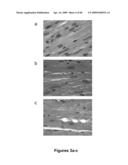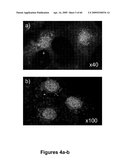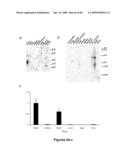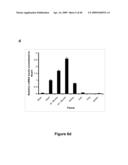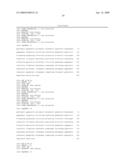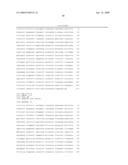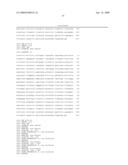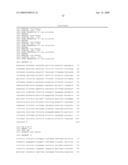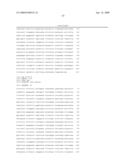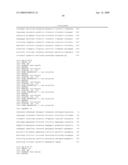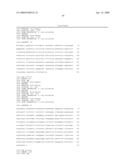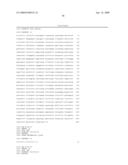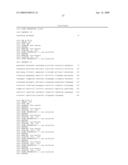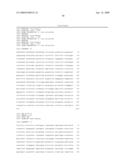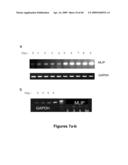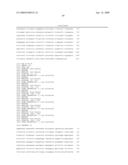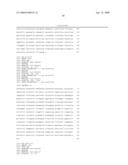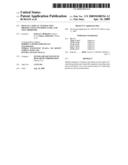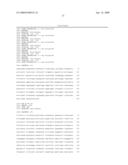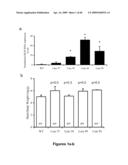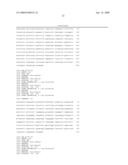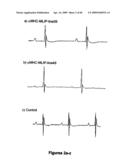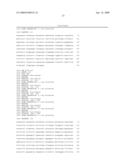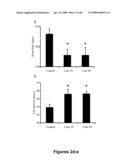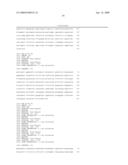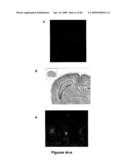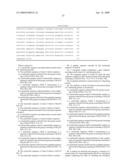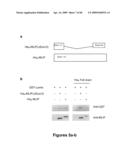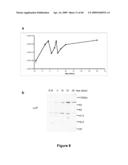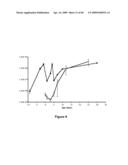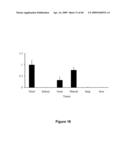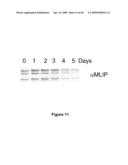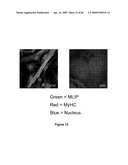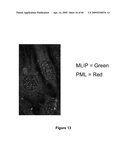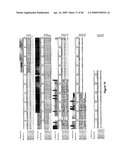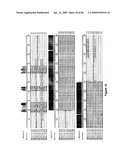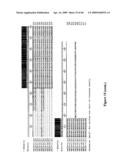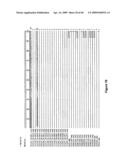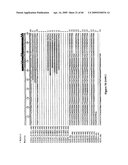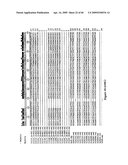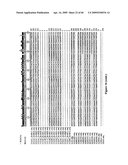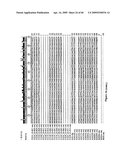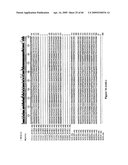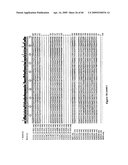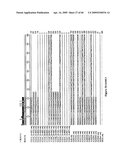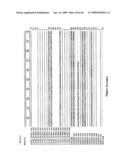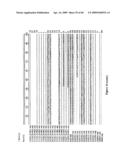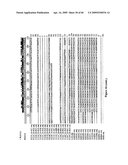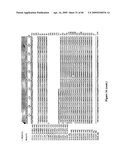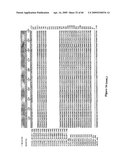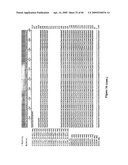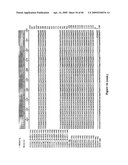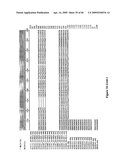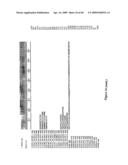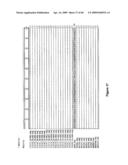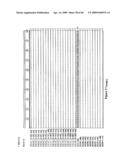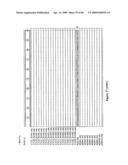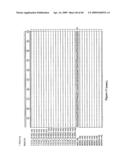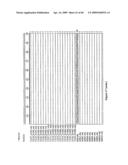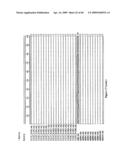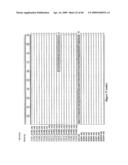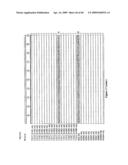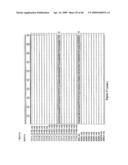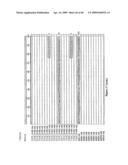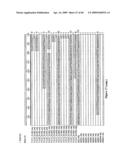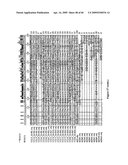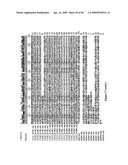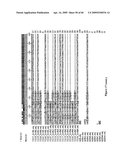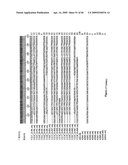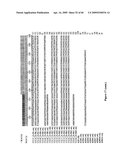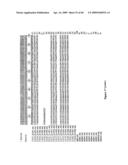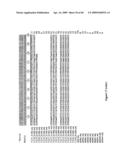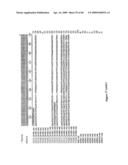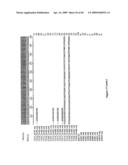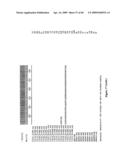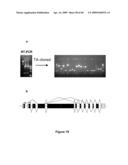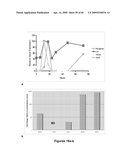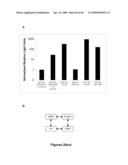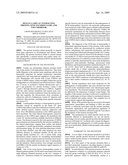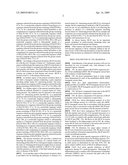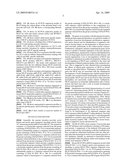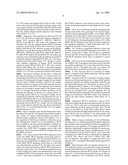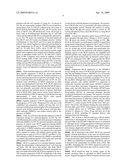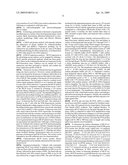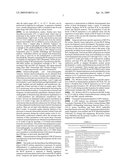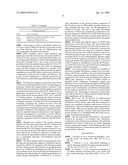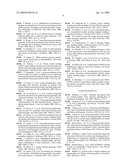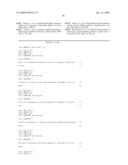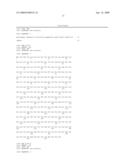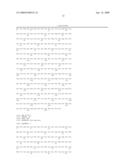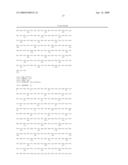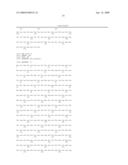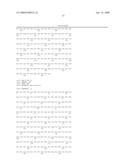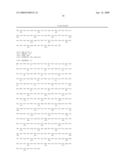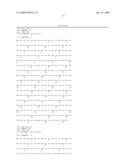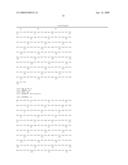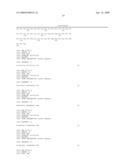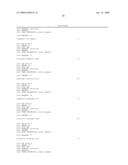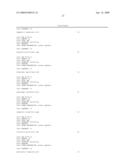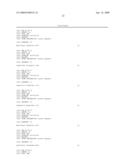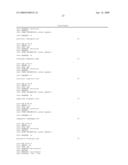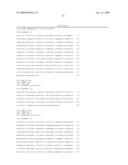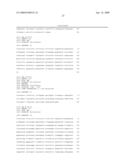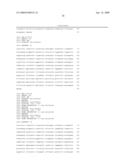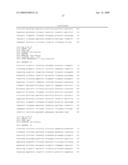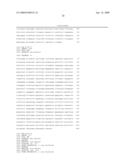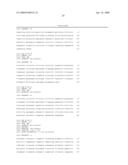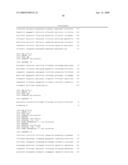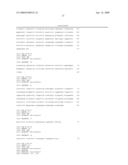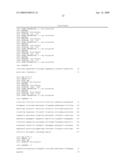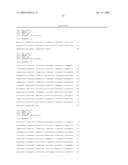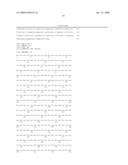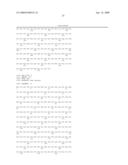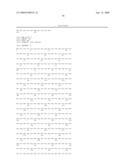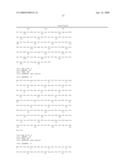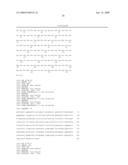Patent application title: MUSCLE LAMIN A/C INTERACTING PROTEIN, GENE ENCODING SAME, AND USES THEREFOR
Inventors:
Patrick G. Burgon (Ottawa, CA)
Elmira Ahmady (Ottawa, CA)
Assignees:
OTTAWA HEART INSTITUTE RESEARCH CORPORATION
IPC8 Class: AA01K67027FI
USPC Class:
800 9
Class name: Multicellular living organisms and unmodified parts thereof and related processes nonhuman animal the nonhuman animal is a model for human disease
Publication date: 2009-04-16
Patent application number: 20090100534
Claims:
1. A nucleotide sequence encoding human muscle lamin A/C interacting
protein.
2. The nucleotide sequence of claim 1 which comprises:a) a nucleotide sequence selected from the group consisting of SEQ ID NOs: 80 to 106;b) a nucleotide sequence which is substantially similar to a sequence selected from the group consisting of SEQ ID NOs: 80 to 106;c) a nucleotide sequence which is homologous to a sequence selected from the group consisting of SEQ ID NOs. 80 to 106;d) a nucleotide sequence which hybridizes to the complement of a sequence selected from the group consisting of SEQ ID NO: 80 to 106; ore) a nucleotide sequence which encodes a peptide sequence selected from the group consisting of SEQ ID NOs: 75 to 79.
3. The nucleotide sequence of claim 1 which is SEQ ID NO: 88.
4. The nucleotide sequence of claim 1 which is isolated.
5. A peptide sequence encoded by the nucleotide sequence of claim 1.
6. A nucleotide sequence encoding murine muscle lamin A/C interacting protein.
7. The nucleotide sequence of claim 6 which comprises:a) a nucleotide sequence selected from the group consisting of SEQ ID NOs: 47 to 74;b) a nucleotide sequence which is substantially similar to a sequence selected from the group consisting of SEQ ID NOs: 47 to 74;c) a nucleotide sequence which is homologous to a sequence selected from the group consisting of SEQ ID NOs. 47 to 74;d) a nucleotide sequence which hybridizes to the complement of a sequence selected from the group consisting of SEQ ID NO: 47 to 74; ore) a nucleotide sequence which encodes a peptide sequence selected from the group consisting of SEQ ID NOs: 7 to 16.
8. The nucleotide sequence of claim 6 which is SEQ ID NO: 57.
9. The nucleotide sequence of claim 6 which is isolated.
10. A peptide sequence encoded by the nucleotide sequence of claim 6.
11. A transgenic animal comprising a gene sequence encoding muscle lamin A/C interacting protein.
12. The transgenic animal of claim 11 where the gene sequence comprises a DNA sequence selected from the group consisting of SEQ ID NOs: 1 to 6, 47 to 74 or 80 to 106.
13. An antibody directed to a muscle lamin A/C interacting protein.
14. The antibody of claim 13 wherein said muscle lamin A/C interacting protein is encoded by:a) a nucleotide sequence selected from the group consisting of SEQ ID NOs: 47 to 74;b) a nucleotide sequence which is substantially similar to a sequence selected from the group consisting of SEQ ID NOs: 47 to 74;c) a nucleotide sequence which is homologous to a sequence selected from the group consisting of SEQ ID NOs. 47 to 74;d) a nucleotide sequence which hybridizes to the complement of a sequence selected from the group consisting of SEQ ID NO: 47 to 74;e) a nucleotide sequence which encodes a peptide sequence selected from the group consisting of SEQ ID NOs: 7 to 16;f) a nucleotide sequence selected from the group consisting of SEQ ID NOs: 80 to 106;g) a nucleotide sequence which is substantially similar to a sequence selected from the group consisting of SEQ ID NOs: 80 to 106;h) a nucleotide sequence which is homologous to a sequence selected from the group consisting of SEQ ID NOs. 80 to 106;i) a nucleotide sequence which hybridizes to the complement of a sequence selected from the group consisting of SEQ ID NO: 80 to 106; orj) a nucleotide sequence which encodes a peptide sequence selected from the group consisting of SEQ ID NOs: 75 to 79.
15. A method for detecting the presence or absence of a muscle lamin A/C interacting protein (MLIP) in a biological sample comprising the steps of: obtaining the biological sample from an animal, labelling an antibody according to claim 13, exposing the sample to the antibody, and evaluating binding of label to sample.
16. A kit for detecting the presence or absence of a muscle lamin A/C interacting protein (MLIP) in a biological sample, the kit comprising an antibody according to claim 13 and instructions for use.
17. A kit for detecting the presence or absence of a nucleotide sequence encoding muscle lamin A/C interacting protein (MLIP) in a sample, the kit comprising one or more primers selected from the group consisting of SEQ ID NO: 17 to 46 and SEQ ID NOs: 93 to 94, together with instructions for use.
Description:
CROSS REFERENCE TO RELATED APPLICATIONS
[0001]The present application claims the benefit of priority from U.S. provisional patent application Ser. No. 60/956,533, filed Aug. 17, 2007, the entire contents of which are herein incorporated by reference.
FIELD OF THE INVENTION
[0002]The present invention relates generally to muscle/brain gene expression in development and disease. More particularly, the present invention relates to muscle lamins and, specifically, a striated muscle and cardiac lamin A/C interacting protein, referred to herein as MLIP, and nucleotide sequences thereof.
BACKGROUND OF THE INVENTION
[0003]Lamins are intermediate filament proteins found only in the nuclei of all multicellular eukaryotes. They form stable filaments at the nuclear inner membrane and are fundamentally important for nuclear architecture, chromatin organization and transcriptional regulation of gene expression. Mammalian cells encode both A-type (LMNA) and B-type (LMNB) lamins, which are highly related but can be distinguished on a biochemical and functional basis. LMNA has 12 exons, is localized to human chromosome 1q21.2-q21.3 and generates two protein isoforms, Lamin A and Lamin C through alternative splicing of LMNA2. Together with the outer nuclear membrane and nuclear pore complexes, the inner nuclear membrane forms the nuclear envelope that separates the chromosomes from cytoplasm in eukaryotic cells [2]. Furthermore, Lamin A/C interacts with numerous other proteins, including tissue-specific transcription factors [7].
[0004]Laminopathies belong to a heterogeneous group of disorders caused by mutations in the lamin A/C gene (LMNA) that affects a specific combination of tissues, such as heart, skeletal muscle, tendons, neurons, adipocytes and bone. Over 180 different mutations in the LMNA gene have been described. The wide clinical heterogeneity caused by mutations in the LMNA gene supports the hypothesis that Lamin A/C protein performs multiple functions in different tissues. The diseases caused by the wide spectrum of LMNA gene mutations are characterized by the extreme variability of the clinical phenotypes, ranging from cardiac and skeletal myopathies to partial lipodystrophy, peripheral neuropathy, and premature aging. No clear genotype-phenotype correlation has been clarified, since the same mutation can cause different diseases in unrelated families [8-10] and even amongst family members [11, 12]. A recent study, using hierarchical cluster analysis for assembling laminopathies into classes based on organ system involvement, uncovered a non-random relationship between the class of laminopathy and the mutation. These positions were strongly associated (p<0.0001) with the nuclear localization signal sequence of Lamin A/C [13].
[0005]One of the seven known laminopathies results in dilated cardiomyopathy (DCM) and is associated with at least eight different clustered missense in the rod 1 domain of Lamin A/C. Alteration of lamin A/C interaction(s) with heart specific factor(s) may be responsible for the pathogenesis of DCM laminopathies. However, the molecular pathogenesis from mutations in the LMNA gene to dilated cardiomyopathy with conduction disease is relatively unknown. Further, the molecular mechanisms for the relationship between tissue specificity of laminopathies and mutations in the LMNA gene are not understood. There remains a need to understand how these different pathologies arise from alterations in the same gene (LMNA) that is almost ubiquitously expressed in adult cells.
[0006]The diagnosis of the DCM type of laminopathy is particularly important because of the severity of the cardiac symptoms, which are characterized by conduction system defects, arrhythmias, left ventricular dysfunction, and dilation causing heart failure and subsequent death [14]. Conduction system disease may be observed in the absence of cardiomyopathy [9, 19, 20] or it may proceed cardiac dilation [21]. Severe progression of conduction system disease in laminopathies is typically characterized by sinus node dysfunction, progressive atrioventricular blockage, paroxysmal atrial fibrillation, and frequent premature ventricular beats [8, 9, 17, 20, 22-27]. About half of affected patients suffer sudden cardiac death due to lethal ventricular tachyarrhythmias, despite pacemaker implantation [8, 17, 25, 27-29]. Fibrofatty infiltration of the sinoatrial and the atrioventricular node, as well as the atrioventricular bundle have been described in humans with LMNA mutations as histopathological correlation to their cardiac conduction system disease [22, 24, 25, 30].
[0007]Several hypotheses have been proposed for the pathogenesis of laminopathies and most research has been focused on the `mechanical stress` and `altered gene regulation` hypotheses. The structural integrity of the nucleus may be affected by the expression of mutant A-type lamins. The fragility of the nuclear envelope is believed to contribute (in part) to pathologies in tissues subject to mechanical stresses, such as skeletal and cardiac muscle. The complete loss of A-type lamins supports this hypothesis.
[0008]Many of the proteins that are involved in chromatin organization, transcription and binding to DNA are either directly or indirectly associated with the nuclear envelope. Chromatin organization and transcriptional regulation of gene expression is, therefore, affected in specific ways due to the disruption of the nuclear envelope [34].
[0009]The mechanisms by which specific tissue are dramatically affected in laminopathies are not yet known. Knowledge of novel cardiac specific proteins that specifically interacts with lamin A/C would provide a means for diagnosing and treating the pathogenesis of cardiovascular disease and, more particularly, dilated cardiomyopathy with conduction disease.
SUMMARY OF THE INVENTION
[0010]It is an object of the present invention to provide a novel muscle specific protein involved in muscular, brain and/or cardiovascular disease or development, and a nucleotide sequence thereof.
[0011]In a first aspect of the present invention there is provided nucleotide sequences encoding human or murine muscle lamin A/C interacting protein (hMLIP, mMLIP).
[0012]In embodiments of the present invention, the nucleotide sequences comprise a) a nucleotide sequence selected from the group consisting of SEQ ID NOs: 47 to 74; b) a nucleotide sequence which is substantially similar to a sequence selected from the group consisting of SEQ ID NOs: 47 to 74; c) a nucleotide sequence which is homologous to a sequence selected from the group consisting of SEQ ID NOs. 47 to 74; d) a nucleotide sequence which hybridizes to the complement of a sequence selected from the group consisting of SEQ ID NO: 47 to 74; e) a nucleotide sequence which encodes a peptide sequence selected from the group consisting of SEQ ID NOs: 7 to 16; f) a nucleotide sequence selected from the group consisting of SEQ ID NOs: 80 to 106; g) a nucleotide sequence which is substantially similar to a sequence selected from the group consisting of SEQ ID NOs: 80 to 106; h) a nucleotide sequence which is homologous to a sequence selected from the group consisting of SEQ ID NOs. 80 to 106; i) a nucleotide sequence which hybridizes to the complement of a sequence selected from the group consisting of SEQ ID NO: 80 to 106; or j) a nucleotide sequence which encodes a peptide sequence selected from the group consisting of SEQ ID NOs: 75 to 79.
[0013]According to the present invention, MLIP can interact with the rod 1 domain of lamin A/C. Preliminary experiments confirmed specific expression of MLIP in the hearts of E11.5 mouse embryos, neonatal and adult mouse hearts, striated muscles and brains. The full length human and mouse MLIP cDNAs have been cloned and at least four MLIP splice variants are evident in both human and mouse. MLIP is located at 6p12.1 of the human chromosome.
[0014]In another aspect of the present invention there is provided a transgenic animal comprising a gene sequence encoding cardiac lamin A/C interacting protein. The transgenic animal can comprise a DNA sequence selected from the group consisting of SEQ ID NOs: 1 to 6, 47 to 74 or 80 to 106.
[0015]In a further aspect of the present invention there is provided an antibody directed to a muscle lamin A/C interacting protein. The antibody may be directed to the muscle lamin A/C interacting protein encoded by: a) a nucleotide sequence selected from the group consisting of SEQ ID NOs: 47 to 74; b) a nucleotide sequence which is substantially similar to a sequence selected from the group consisting of SEQ ID NOs: 47 to 74; c) a nucleotide sequence which is homologous to a sequence selected from the group consisting of SEQ ID NOs. 47 to 74; d) a nucleotide sequence which hybridizes to the complement of a sequence selected from the group consisting of SEQ ID NO: 47 to 74; e) a nucleotide sequence which encodes a peptide sequence selected from the group consisting of SEQ ID NOs: 7 to 16; f) a nucleotide sequence selected from the group consisting of SEQ ID NOs: 80 to 106; g) a nucleotide sequence which is substantially similar to a sequence selected from the group consisting of SEQ ID NOs: 80 to 106; h) a nucleotide sequence which is homologous to a sequence selected from the group consisting of SEQ ID NOs. 80 to 106; i) a nucleotide sequence which hybridizes to the complement of a sequence selected from the group consisting of SEQ ID NO: 80 to 106; or j) a nucleotide sequence which encodes a peptide sequence selected from the group consisting of SEQ ID NOs: 75 to 79.
[0016]The present invention also provides a method for detecting the presence or absence of a muscle lamin A/C interacting protein (MLIP) in a biological sample comprising the steps of: obtaining the biological sample from an animal, and providing a labelled antibody to MLIP to the sample, whereby presence or absence of the label indicates the presence or absence of the MLIP.
[0017]In yet another aspect of the present invention, there is provided a kit for detecting the presence or absence of a muscle lamin A/C interacting protein (MLIP) in a biological sample, the kit comprising an antibody to MLIP and instructions for use. In one embodiment, the kit is for detecting the presence or absence of a nucleotide sequence encoding muscle lamin A/C interacting protein (MLIP) in a sample and comprises one or more primers selected from the group consisting of SEQ ID NO: 17 to 46 and SEQ ID NOs: 93 to 94, together with instructions for use.
[0018]As shown herein, MLIP may be an important genetic modulator in cardiovascular (including brain and heart) and muscle development and disease.
[0019]Other aspects and features of the present invention will become apparent to those ordinarily skilled in the art upon review of the following description of specific embodiments of the invention in conjunction with the accompanying figures.
BRIEF DESCRIPTION OF THE DRAWINGS
[0020]Embodiments of the present invention will now be described, by way of example only, with reference to the attached Figures, wherein:
[0021]FIG. 1a shows relative MLIP RNA expression levels of four established αMHC-MLIP transgenic mouse lines with evidence of mild hypertrophy.
[0022]FIG. 1b shows preliminary heart to body weight ratios determined for each of the established αMHC-MLIP transgenic mouse lines.
[0023]FIGS. 2a-c show representative electrocardiographic profiles of a) αMHC-MLIP transgenic mouse Line 39 (n=6); b) αMHC-MLIP transgenic mouse Line 49 (n=4); and c) control mice (n=8).
[0024]FIG. 2d shows comparative heart rates in the MLIP transgenic mouse lines compared to control mice.
[0025]FIG. 2e shows comparative P-R intervals of MLIP transgenic mouse lines compared to control mice.
[0026]FIGS. 3a-c shows histological analysis of a) five week old wildtype mouse; b) a first five week old αMHC MLIP transgenic mouse line in accordance with the present invention; and c) a second five week old αMHC-MLIP transgenic mouse line in accordance with the present invention.
[0027]FIGS. 4a-b show endogenous MLIP localized to both the nucleus and cytosol of rat neonatal myocytes at a) 40× magnification and b) 100× magnification. FIG. 4c shows C2C12 cells co-stained with specific polyclonal antibodies for MLIP and PML. FIG. 4d shows in situ MLIP in mouse brain localized to the hippocampus and in FIG. 4e, endogenous MLIP (red) was localized to the nuclei and cytosol of rat hippocampal neurons and glial cells.
[0028]FIG. 5a illustrates two major splice variants of MLIP were cloned from mouse heart. FIG. 5b shows a western blot analysis of bacterial-expressed His6-MLIP and GST-Lamin recombinant proteins.
[0029]FIGS. 6a-b show specific expression of MLIP in a) mouse tissue and b) human tissue, by Northern analysis. FIG. 6c shows normalized tissue distribution of MLIP expression in adult mouse as determined by real time PCR. FIG. 6d shows relative mRNA levels of MLIP in different tissues.
[0030]FIGS. 7a-b show specific induction of MLIP expression during P19 cardiomyogenesis, illustrating P19 differentiation into a) cardiac cells in the presence of dimethyl sulfoxide (DMSO); and b) neuronal and glial cells in the presence of retinoic acid.
[0031]FIG. 8a shows an RT-PCR expression profile of MLIP during the critical phase of the perinatal heart's exit from the cell cycle. FIG. 8b shows a corresponding Western blot.
[0032]FIG. 9 shows an RT-PCR expression profile of MLIP for wild type hearts (closed circles) and MYBPC3 deficient hearts (open circles).
[0033]FIG. 10 shows relative adult tissue specific expression of MLIP as determined by qualitative RT-PCR.
[0034]FIG. 11 shows a Northern blot of MLIP expression in C2C12 cells during myotube formation.
[0035]FIG. 12 shows MLIP expression in C2C12 cells during myotube formation by indirect immunoflorescence staining with a MLIP specific antibody.
[0036]FIG. 13 shows MLIP co-localized with PML bodies in C2C12 cells by indirect immunoflorescence staining with a MLIP and PML specific antibodies.
[0037]FIG. 14 shows an amino acid sequence alignment of human MLIP proteins hMLIP-1, hMLIP-2, hMLIP-3, hMLIP-4 and hMLIP-5. The amino acid sequences were translated from the five different human MLIP nucleotide sequences cloned (SEQ ID NOs: 80 to 106) from a pooled human cDNA library.
[0038]FIG. 15 shows an amino acid sequence alignment of mouse MLIP proteins mMLIP-01, mMLIP-02, mMLIP-03, mMLIP-04, mMLIP-05, mMLIP-06, mMLIP-07, mMLIP-08, mMLIP-09 and mMLIP-10. The amino acid sequences were translated from the ten different mouse MLIP nucleotide sequences cloned (SEQ ID NOs: 47 to 74) from a pooled mouse heart cDNA library
[0039]FIG. 16 shows a nucleotide sequence alignment of human MLIP nucleotide sequences cloned (SEQ ID NOs: 80 to 106) from a pooled human cDNA library.
[0040]FIG. 17 shows a nucleotide sequence alignment of mouse MLIP nucleotide sequences cloned (SEQ ID NOs: 47 to 74) from a pooled mouse heart cDNA library.
[0041]FIG. 18 shows the results of direct cloning of MLIP. FIG. 18a shows RT-PCR results. FIG. 18b is an alternative splice map of MLIP.
[0042]FIG. 19 shows representative expression profiles a) for muscle specific genes, and b) following overexpression of MLIP.
[0043]FIGS. 20a-b show results of yeast-two hybrid of MLIP and LMO7.
DETAILED DESCRIPTION
[0044]Generally, the present invention provides novel human and mouse gene sequences encoding muscle lamin A/C interacting protein (hMLIP and mMLIP). The sequences comprise: a) a nucleotide sequence selected from the group consisting of SEQ ID NOs: 47 to 74; b) a nucleotide sequence which is substantially similar to a sequence selected from the group consisting of SEQ ID NOs: 47 to 74; c) a nucleotide sequence which is homologous to a sequence selected from the group consisting of SEQ ID NOs. 47 to 74; d) a nucleotide sequence which hybridizes to the complement of a sequence selected from the group consisting of SEQ ID NO: 47 to 74; e) a nucleotide sequence which encodes a peptide sequence selected from the group consisting of SEQ ID NOs: 7 to 16; f) a nucleotide sequence selected from the group consisting of SEQ ID NOs: 80 to 106; g) a nucleotide sequence which is substantially similar to a sequence selected from the group consisting of SEQ ID NOs: 80 to 106; h) a nucleotide sequence which is homologous to a sequence selected from the group consisting of SEQ ID NOs. 80 to 106; i) a nucleotide sequence which hybridizes to the complement of a sequence selected from the group consisting of SEQ ID NO: 80 to 106; or j) a nucleotide sequence which encodes a peptide sequence selected from the group consisting of SEQ ID NOs: 75 to 79.
[0045]The genes in accordance with the present invention, and the proteins expressed therefrom, are useful for studies of regulation of myocyte development, proliferation, regeneration and/or disease and for identification of regulatory substances having impact on developmental or disease-associated outcomes, particularly in the cardiovascular sciences. Furthermore, transgenic animals comprising the gene can be used as a model to examine regulation of myocyte development, proliferation, regeneration or disease and identification of novel drug targets muscle and cardiovascular disease, and muscle regeneration. Loss or mis-regulation of MLIP may contribute to alterations in cardiac development. Further, loss or mis-regulation of MLIP may contribute to the onset and development of dilated cardiomyopathy with conduction disease. This is suggested by data obtained from investigating the effects of altered gene expression of MLIP in murine models as described herein. Preliminary investigation suggests that MLIP may be associated with the simultaneous development of both Dunnigans-type familial partial lipodystrophy (non-striated muscle laminopathy) and dilated cardiomyopathy. MLIP may also be involved in other muscular dystrophies, not necessarily cardiac related. Furthermore, MLIP expression in terminally differentiated cells of brain, muscle and heart may play a role in normal development, disease and regeneration.
[0046]Identification and initial characterization of a novel Lamin A/C interacting protein, MLIP: To identify heart specific proteins that interact with the rod 1 domain of lamin A/C, a yeast two-hybrid interaction screen was utilized. Proteins encoded by a human heart complementary DNA library (Clontech) were screened for their ability to interact with the rod 1 domain of Lamin A/C. Of the 3.5×106 independent clones screened, 232 clones were positive in the presence of the rod 1 domain of lamin A/C; thus, the DNA sequence of the 232 positive clones were determined. The MLIP clone, which was represented by 6 independent clones out of the 232, was found to be homologous to 49 expressed sequence tags (ESTs) present within GenBank® online database. The clone was mapped to human chromosome 6p12.1 and subsequently identified as a putative open reading frame (C6orf142, GenBank accession number: NM--138569). The mouse homologue is mapped to mouse chromosome 9E.
[0047]The MLIP cDNA clone contains 13 exons that span over 247 kilobases and is predicted to translate a 458 amino-acid protein. Comparisons of the deduced 458-amino-acid protein, or the nucleic acid sequence with the GenBank database, revealed no substantial similarities with any other protein other than homologous forms in non-human genomes or EST databases. Initially, no structural or functional domain was identified within the primary amino acid sequence or the nucleic acid sequence of MLIP.
[0048]Mouse MLIP DNA shRNAi sequences are provided (SEQ ID NO: 1 to 6). Putative amino acid sequences corresponding to mouse MLIP DNA sequence fragments were determined (SEQ ID NOs: 7 to 16). PCR primers for mouse MLIP (SEQ ID NOs: 17 to 46) were constructed to generate PCR products forming contigs (SEQ ID NOs: 47 to 56 and 58 to 74) to construct the entire mouse MLIP gene (SEQ ID NO: 57). PCR primers for human MLIP (SEQ ID NOs: 93-94) were used to generate PCR products forming contigs of the various splice variants (SEQ ID NOs: 80 to 87 and 89 to 106) of the full length sequence of the human MLIP gene (SEQ ID NO: 88). Putative human peptide sequences were obtained (SEQ ID NOs: 75 to 79).
[0049]Alignments of the sequences are shown in FIGS. 14 to 17. FIG. 14 shows an amino acid sequence alignment of human MLIP proteins hMLIP-1, hMLIP-2, hMLIP-3, hMLIP-4 and hMLIP-5. The amino acid sequences were translated from the five different human MLIP nucleotide sequences cloned (SEQ ID NOs: 80 to 106) from a pooled human cDNA library. FIG. 15 shows an amino acid sequence alignment of mouse MLIP proteins mMLIP-01, mMLIP-02, mMLIP-03, mMLIP-04, mMLIP-05, mMLIP-06, mMLIP-07, mMLIP-08, mMLIP-09 and mMLIP-10. The amino acid sequences were translated from the ten different mouse MLIP nucleotide sequences cloned (SEQ ID NOs: 47 to 74) from a pooled mouse heart cDNA library. FIG. 16 shows a nucleotide sequence alignment of human MLIP nucleotide sequences cloned (SEQ ID NOs: 80 to 106) from a pooled human cDNA library. FIG. 17 shows a nucleotide sequence alignment of mouse MLIP nucleotide sequences cloned (SEQ ID NOs: 47 to 74) from a pooled mouse heart cDNA library.
[0050]The present invention also provides a method for detecting the presence or absence of a muscle lamin A/C interacting protein (MLIP) in a biological sample comprising the steps of: obtaining the biological sample from an animal, and providing a labelled antibody to MLIP to the sample, whereby presence or absence of the label indicates the presence or absence of the MLIP. The sequences can be detected using a kit according to another aspect of the present invention. For example, the present invention provides a kit for detecting the presence or absence of a muscle lamin A/C interacting protein (MLIP) in a biological sample, the kit comprising an antibody to MLIP and instructions for use. In another embodiment, the kit is for detecting the presence or absence of a nucleotide sequence encoding muscle lamin A/C interacting protein (MLIP) in a sample, the kit comprising one or more primers selected from the group consisting of SEQ ID NO: 17 to 46 and SEQ ID NOs: 93 to 94, together with instructions for use.
[0051]MLIP transgenic mice develop bradycardia with a prolonged P-R interval with abnormal myocardial morphology: Lamin A/C linked cardiomyopathies are known to develop cardiac conduction disease with dilation. Loss or mis-regulation of MLIP may contribute to alterations in cardiac development. Further, loss or mis-regulation of MLIP may contribute to the onset and development of dilated cardiomyopathy with conduction disease. To investigate this concept, four αMHC-MLIP transgenic mouse lines were generated. These mice possess the MLIP transgene driven by the αMHC promoter.
[0052]FIG. 1 shows relative MLIP RNA expression levels of the four αMHC-MLIP transgenic mouse lines with evidence of mild hypertrophy. FIG. 1a shows MLIP RNA concentrations from adult hearts of wildtype (WT, n=4) and each of the αMHC-MLIP transgenic mouse lines (n=2 per line) were determined by real-time PCR. All values were normalized to the mean concentration of MLIP RNA expression of wild-type control mice. FIG. 1b illustrates preliminary heart to body weight ratios which were determined for each of the established αMHC-MLIP transgenic mouse lines (*p<0.005 vs WT). These data established a 4 to 50-fold increase in MLIP RNA expression over wild-type control mice with a trend towards increased heart to body weight ratios at 5 weeks of age.
[0053]FIGS. 2a to 2c illustrate that MLIP transgenic mice develop bradycardia with a prolonged P-R interval. Representative electrocardiographic profiles of two αMHC-MLIP transgenic mouse lines and a control mouse are shown: FIG. 2a Line 39 (n=6), FIG. 2b Line 49 (n=4) and FIG. 2c control (n=8). Preliminary electrogardiographic studies of two of the βMHC-MLIP transgenic mouse lines reveal the progressive and significant appearance of both bradycardia with a prolonged P-R intervals in each of the lines.
[0054]FIG. 2d shows a significant reduction of heart rate (p<0.02) observed in both MLIP transgenic mouse lines compared to control mice. Further, FIG. 2e shows a significant increase (p<0.02) in the prolongation of the P-R interval of both MLIP transgenic mouse lines as compared to control mice.
[0055]FIGS. 3a to 3c show preliminary histological analysis of βMHC-MLIP transgenic mouse lines shows abnormal myocardial morphology. Five week old mouse hearts from a) wild-type and b-c) transgenic mice that over express the MLIP were fixed, sectioned and stained by H&E protocol.
[0056]To date, there has been no occurrence of sudden death or congestive heart failure phenotype with the oldest (16 weeks) transgenic mice.
[0057]Endogenous MLIP is localized to both the nucleus and cytosol of rat neonatal myocytes: Using an MLIP specific polyclonal antibody, the cellular localization of MLIP in rat neonatal cardiomyocytes was determined. As shown in FIG. 4a, endogenous MLIP appears to be localized in both the cytosol and nucleus. The cytosolic staining of MLIP is diffuse but may be associated with a cytosolic organelle. FIG. 4b shows that the nuclear staining MLIP is punctate in nature and suggests co-localization with PML bodies of the nucleus as well as the inner nuclear membrane where lamin A/C is found.
[0058]Endogenous MLIP is localized to mouse C2C12 cells and rat hippocampal glial and neuronal cells. As shown in FIG. 4c, C2C12 cells were co-stained with specific polyclonal antibodies for MLIP (green) and PML (red). FIG. 4d shows in situ MLIP in mouse brain (Allen Mouse Brain Institute) localized to the hippocampus and in FIG. 4e, endogenous MLIP (red) was localized to the nuclei (green) and cytosol of rat hippocampal neurons (map2, blue) and glial cells.
[0059]Within 12 hours of initiation of C2C12 differentiation there is an ˜2.5-fold increase in MLIP mRNA expression that coincides with a transient Myf5 and MyoD up regulation, followed by an up regulation of myogenin and MLIP. FIG. 19ashows representative expression profiles for muscle specific genes, between 0 and 72 hours of differentiation. C2C12 cells transfected with pCDNA3.1-MLIP vector show that overexpression of MLIP results in subsequent up-regulation of MLIP, Pax7, MyoD and VGLL2 mRNA (FIG. 19b; ND=not detected). This appears to suggest that MLIP may regulate PAX7, a myogenic determinant during regenerative myogensis.
[0060]MLIP interacts with rod 1 domain of lamin A/C: In vitro pull-down assays were performed using recombinant hexa-histidine-MLIP and GST-lamin-rod I to determine if the observed interaction between MLIP and the rod I domain of lamin A/C, as observed in the yeast-hybrid assay, is a direct or indirect interaction. FIG. 5 illustrates that MLIP directly interacts with the rod I domain of Lamin A/C. As shown in FIG. 5a, two major splice variants of MLIP were cloned from mouse heart. Exon 3 of MLIP is absent in the short form of MLIP. Both the full length MLIP (His6-MLIP) and the short form of MLIP (His6-MLIP(ΔExon3)) were sub-cloned in frame with an N-terminal hexa-histadine tag of a pET100 vector and recombinant MLIP was subsequently expressed in E.coli. FIG. 5b shows the isolation of bacterial-expressed His6-MLIP and GST-Lamin recombinant proteins. Various combinations of His6-MLIP and GST-Lamin recombinant proteins were mixed together (as indicated) and incubated at room temperature for 60 min in 10 mM Phosphate buffer (pH7.4), 50 mM NaCl, 0.05% triton X-100. Ni2+-NTA sepharose beads were added to each reaction mixture (right panels) and complexes were isolated and washed by centrifugation in phosphate buffer (pH7.4), 50 mM NaCl, 0.05% triton X-100. Complexes were eluted by addition of SDS-PAGE loading buffer, boiled, and resolved by SDS-PAGE. Western analysis was performed using anti-GST (Cell Signaling) and anti-MLIP polyclonal antibodies. A 1:10 dilution of the total starting material was run on the same gel (left panels). Assay was repeated two additional times with similar results.
[0061]Heart-enriched expression of MLIP: FIGS. 6a to 6c show specific expression of MLIP in mouse and human. Distribution of MLIP expression by Northern analysis in a) mouse and b) human tissues revealed two transcripts. 10 ug of poly-A enriched RNA was loaded per lane. In FIG. 6c, normalized tissue distribution of MLIP expression in adult mouse was determined by real time PCR. MLIP expression profile by Northern analysis demonstrated that MLIP expression was primarily associated with the heart and brain in mouse and heart and skeletal muscle in human. Real-time PCR of MLIP RNA from various mouse tissues showed a similar distribution of MLIP expression with the heart having approximately 3 times more MLIP, with smooth muscle>skeletal muscle>heart (FIG. 6d).
[0062]Specific induction of MLIP expression during cardiomyogensis of P19 cells: Pluripotent P19 cells are a well established and extensively studied cell line that can be induced to differentiate neuronal/glial cells in the presence of retinoic acid, skeletal muscle cells (retinoic acid plus dimethyl sulfoxide (DMSO)), and cardiac muscle cells in the presence of DMSO.
[0063]FIGS. 7a to 7b show the specific induction of MLIP expression during P19 cardiomyogenesis. In FIG. 7a, P19 cell differentiate into cardiac cells in the presence of dimethyl sulfoxide (DMSO). In FIG. 7b, neuronal and glial cells in the presence of retinoic acid. MLIP expression during DMSO induced cardiomyogenesis of P19 cells increased dramatically at day 5 of DMSO induction and continued through day 9. The MLIP expression at day 5 was shown to be concurrent with a number of cardiac and striated muscle specific transcription factors such as GATA-4, MEF2C and Nkx2.5 [35]. This induction of MLIP expression by DMSO is specifically associated with cardiomyogensis of P19 cells since neuronal differentiated P19 cells did not express MLIP.
[0064]MLIP is expressed in a transient biphasic manner during the critical phase of the perinatal heart's exit from the cell cycle. FIG. 8a shows that shortly after birth, MLIP mRNA expression is up-regulated in the heart and peaks at 4 days post-birth followed by MLIP down-regulation by day 5. This transient expression of MLIP corresponds to the same period which the cardiomyocytes are exiting their last round of cell division with the absence of cytokinesis. The reactivation of MLIP after day 5 is associated with adult cardiomyocyte hypertrophic growth. Western blot analysis of endogenous MLIP through this period reveals a switch in LIP isoform distribution from a short MLIP form to a long MLIP form (FIG. 8b).
[0065]At least four alternative splice forms of MLIP have been identified through direct cloning or RACE analysis. FIG. 18 shows the results of direct cloning. In FIG. 18a, RT-PCR (left panel) was performed on mRNA isolated from mouse hearts using primers targeted to the 5'- and 3'-UTR of MLIP as defined by the EST database. The RT-PCR product was TA cloned into pCR-II plasmid and transformed into bacteria. Direct PCR was performed with primers targeting flanking regions of the MLIP insertion site amplified four different product sizes (right panel) with each PCR product sequenced. Based on these data, an alternative splice map of MLIP was constructed (FIG. 18b). It appears that the MLIP gene comprises 12 exons and is regulated by two putative promoters with exon 1a only observed in cDNA cloned from muscle and both exons 1a and 1b observed in cDNA cloned from brain.
[0066]Suppressed MLIP expression in the MYBPC3 mouse during the onset of DCM in the perinatal heart. Cardiac Myosin Binding Protein-C (MYBPC3) is a 1274 amino acid thick filament accessory protein component of the striated muscle sarcomere A band that constitutes 2% to 4% of the myofibril. Although there are four MYBPC3 genes in the human genome, only cardiac MYBPC3 is expressed in embryonic, neonatal, and adult hearts. MYBPC3 interacts with at least three sarcomere components: myosin heavy chain, actin, and titin. More than 30 cardiac MYBP3 gene mutations have been identified as causes of hypertrophic cardiomyopathy (HCM); an autosomal dominant disorder resulting from defective sarcomeres. The majority of cardiac MYBPC3 mutations are predicted to encode truncated proteins that lack portions of either the carboxyl myosin and/or titin binding domains. Mice that express mutant cardiac MYBPC3 to create murine HCM models have been produced. These mice, like humans bearing the same mutation, develop adult onset HCM. Homozygous mice that express two mutant alleles and no wild-type cardiac MYBPC3 develop LV dilation by 3 days of age and have all of the features of DCM, including LV chamber dilation with impaired fractional shortening.
[0067]FIG. 9 shows a 30-fold reduction in MLIP mRNA expression as determined by real-time PCR, observed by 1 day post-birth in the MYBPC3 deficient mouse as compared to wild-type mouse. During the period of abnormal myocyte proliferation in the MYBPC3 deficient mice, MLIP expression remains suppressed and then by 10 days MLIP expression has returned to normal levels.
[0068]MLIP interaction with LMO7. MLIP was screened against a human heart library in the yeast two-hybrid assay. LMO7, an emerin-binding protein that regulates transcription of emerin and many other muscle relevant genes (Holaska et. al. 2006), was identified as interacting with MLIP, and was confirmed in the mammalian two-hybrid assay (FIGS. 20a and 20b). Disrupting the LIP-LMNA interaction and/or the regulation of MLIP expression may result in a gain of function.
[0069]MLIP knock-out mice In another aspect of the present invention there is provided an MLIP knock-out mouse. Targeted disruption of MLIP in knock-out mice (such as by insertion of LacZ cDNA) may result in alterations of the following as compared to wild-type mice:
[0070]a) echocardiographic and electrocardiograpic (ECG) output;
[0071]b) histology, particularly in the hearts of genetically modified mice at a variety of key developmental stages. Heart sections likely demonstrate alterations/aberrations in myocardium morphology (H&E stain) and fibrosis (Masson Trichrome).
[0072]c) RNA and protein analysis will typically indicate the expression of classic markers for cardiomyopathies (ANF, BNP and βMHC). Expression profiling can be achieved by any method known in the art, such as Northern and Western blotting (for RNA and protein), or Southern blots or DNA chip analysis (for DNA analysis).
[0073]d) MLIP expression analysis--MLIP expression in the developing mouse embryo can be mapped by utilizing a MLIP specific polyclonal antibody which has been generated. These can be confirmed by the nlsLacZ expression in the MLIP-knockout mice. Embryos can be stained for LacZ expression and then sectioned to identify and confirm the tissue expression profile of MLIP.
[0074]The knock-out mice of the present may be generated using any known protocol. However, certain modifications may be envisioned by the person of ordinary skill in the art in the context of the present invention with respect to the expression of MLIP. One example of the knock-out mouse protocol is provided herein. The lacZ gene is fused to a nuclear localization signal sequence (nlslacZ) so as to increase the signal to noise ratio of lacZ detection. To generate the MLIP-nlslacZ targeting vector, a fragment containing at least exons 1 and 2 of the MLIP locus is isolated by screening a 129 mouse genomic library (Stratagene) using the total coding region of the mouse MLIP cDNA as a probe. The identified fragment is inserted into the multiple cloning site of pBluescript KS+. An ATG start codon in exon 1 is PCR-modified into an Ncol site, and a BspHI-Xhol nlslacZ cassette is ligated in-frame into exon 1 in between the Ncol and Sall sites. This subclone is flanked on the 3' end with the PGK-hygromycin cassette, thereby deleting the coding sequence in exon 2. The Polyoma thymidine kinase gene obtained from a previously described vector [36] is added 3' of the construct. Embryonic stem (ES) cells, such as those from the 129/Sv mouse line, for example, are transfected with the construct, and homologous recombinants screened by Southern analysis. ES cells with a homologous recombination are then injected into C57BI/6J blastocysts to generate heterozygous MLIP-nlslacZ mice. The mice are genotyped and separated into wild-type or heterozygous mice by Southern blot analysis and PCR based genotyping. Chimeric males are crossed to 129/SeEv females and germline transmission of the injected ES cell lines are monitored by detecting agouti mice among the F1 offspring and subsequent Southern blotting. Heterozygote mice are crossed to generate a homozygote null MLIP mouse. The colony can be expanded to provide sufficient mice for characterization.
[0075]Characterization MLIP mouse models: Mouse models generated can be initially characterized by the following protocols:
[0076]Immunocytochemistry: Cultured cells transiently expressing MLIP were plated on gelatin-coated coverslips. Cells are fixed with 4% paraformaldehyde in PBS on ice for 20 min, followed by three washes of PBS. The fixed cells are then blocked with 10% normal serum in PBS on ice for 60 min followed by a single wash in PBS. The cells will then be incubated in the appropriate primary anti-sera in 1.5% normal serum for 1-2 hours, washed three times in PBS, and then incubated for 60 min with the appropriate secondary anti sera conjugated to a flourophore (Molecular Probes) with 1.5% normal serum. Coverslips are then washed three times in PBS, mounted on glass slides, and analysed with a confocal microscope.
[0077]Northern analysis: Initially, total mouse RNA is isolated from heart, skeletal muscle, brain, liver and kidney at variety of developmental time points (E9.5 through E14.5, 1 day, 14 day and 8 weeks) using TRlzol reagent (Invitrogen). At least 10 μg of total RNA per lane is loaded on a 1% agarose gel (containing 0.42% MOPS, 5 mM sodium acetate, 0.7 mM EDTA, and 0.6% formaldehyde). Electrophoresis is performed in 1×MOPS buffer (0.42% MOPS, 5 mM sodium acetate, 0.7 mM EDTA) with a circulating pump at 40-60 constant volts for about 2-3 hours. The electrophoresis is stopped when the stop dye has migrated about 2/3-3/4 of the way through the gel. The RNA is then transferred overnight to a nylon membrane (pre-wet in 1×MOPS buffer) with a 10×SSPE stock solution (1.5 M NaCl, 0.1 M NaH2PO4, 10 mM EDTA, pH 7.0). The membrane is then be re-hybridized at 42° C. in 50% deionized formamide, 5×SSPE, 50 mM sodium phosphate buffer, pH 6.8, 1× Denhardt's solution, heat denatured salmon sperm DNA to 100-200 μg/ml, and 0.5% SDS for 3-4 hours. Hybridization occurs overnight with a radiolabelled probe at 42° C. in fresh prehybridization buffer with 7.5% dextran sulfate. 25 ng of a DNA probe is labelled with random primers, with MLIP cDNA fragment used as template. The next day, the membranes are washed twice in 2×SSPE, 0.1% SDS at room temperature, 10 minutes per wash, then for 30 minutes in 0.5× or 0.2×SSPE, 0.1% SDS at room temperature. The membrane is then be checked for radioactivity with a hand-held monitor and/or autoradiography before increasing the stringency. Initially, the membrane can be analysed by a phospho-imager and then exposed overnight against film.
[0078]RT-PCR and real time RT-PCR: cDNA is synthesized from total RNA samples (isolated for Northern analysis) by oligo (dT)-primed reverse transcription (Protoscript First Strand cDNA synthesis, New England Biolabs). To characterize MLIP expression in the heart through development, cDNA is subjected to either PCR amplification using HotStarTaq DNA polymerase (Qiagen) or real time quantitative PCR (qPCR). Primers are designed for the specific amplification of MLIP splice isoforms, such that the PCR product length will be 200 to 300 base pairs in length and overlap splice form specific exon boundaries.
[0079]To determine the relative abundance of MLIP isoforms in mouse tissue, qPCR is performed with SYBR green PCR master mix (Roche) using LightCycler 1.0 sequence detection system (Roche). Isoform-specific primers for MLIP [MLIP67 primers, 5'-TTCATCATCCTCAACAGCGT-3' (forward), 5'-GGGTTGGGCTCATAAACTTC-3' (reverse)] and [MLIP3 primers, 5'-TAGCTACTCGGCCCAAGTCT-3' (forward), 5'-ATCCCATGAGGAATTTCAGG-3' (reverse)] are used to analyze transcript abundance with mouse GAPDH transcript levels [GAPDH primers, 5'-GCAACAGGGTGGTGGACCT-3' (forward), 5'-GCAACAGGGTGGTGGACCT-3' (reverse)] serving as an internal control to compensate for differences in RNA recovery and used to normalize the values of transcript abundance of MLIP isoforms. All PCR reactions, cycled 40 times by a two-step cycle procedure (denaturation 95° C., 15s; annealing 65° C., 1 min) after the initial stages (50° C., 1s; 95° C. 10 min), can be performed in triplicate for each gene. To generate a standard curve, serially diluted heart cDNA is included in the 96-well plate along with cDNA from the various tissues.
[0080]In situ hybridization studies. Studies have been described previously [37]. A typical study which may be performed in the context of the present invention is briefly outlined herein. Eight week, 2 week, and newborn mice and E9.5 to E14.5 embryos are dissected free from the uterine muscle and studied. E0.5 is defined as noon on the day postcoitous when a vaginal plug is detected. Embryos are removed, washed in phosphate buffered saline (PBS), fixed overnight in 4% paraformaldhyde in PBS and either frozen (-20° C., 100% methanol) or kept in 70% ethanol at room temperature prior to paraffin embedding and histological analysis. Embedded sections are stained with hematoxylin and eosin or used for in situ hybridization as previously described[38]. Plasmids containing MLIP sequences are used as template for digoigenin (DIG) riboprobes, which are produced according to the manufacture's specifications (Roche). DIG-RNA probes are hybridized overnight at 70° C. and incubated with anti-DIG-AP fragment, and signal detected using Nitro Blue Tetrazolium and 5-bromo-4-chloro-3-indolyl-quadrature-D-galactopyranoside substrates (Roche)[39].
[0081]Electrocardiographic and Echocardiographic Analysis: Surface electrocardiograms can be obtained from anesthetized mice at 2 weeks, 2 months and 4 months of age. Subcutaneous electrodes are inserted in four configurations to obtain 4 electrocardiographic recordings: Lead 1 (right and left forelimb), Lead 2 (left forelimb and right hindlimb), Lead 3 (right forelimb and left hindlimb) and transthoracic (beneath skin of back and skin of chest at cardiac apex). After ECG monitoring, mice are then euthanized by harvesting the heart for biochemical analysis. To monitor the occurrence and frequency of supraventricular arrhythmias, telemetry electrocardiography is obtained using subcutaneous implantation of a radio-transducer and subcutaneous transthoracic electrodes). Devices are implanted under general anaesthesia in mice at 16 weeks of age, mice are allowed to recover for 1 week and are then monitored continuously for 24 hours. Mice are then euthanized and the heart is harvested for biochemical analysis. Mice are not kept with telemetry monitors longer than 3 weeks. To ascertain cardiac diastolic function it was necessary to measure intracardiac pressure/volume loops and diastolic pressures during the normal cardiac cycle in vivo. Intracardiac conductance catheters allow the accurate measurement of these parameters in the mouse heart. Pressure/volume loop measurements are obtained in anesthetized mice at 16 weeks of age by inserting a 1.4 French microcatheter down the carotid artery. This closed-chest preparation is minimally invasive and does not require mechanical ventilation. Echocardiography was performed with an Hewlett Packard Sonos® 4500 ultrasound machine and a 6-15 MHz linear array transducer on anesthetized mice with a heart rate greater than 450 bpm, as previously described [40].
[0082]Characterization of the regulation of MLIP function and expression in the heart during development and the onset of DCM-CCD.
[0083]This study tests the hypothesis that differential regulation of MLIP isoform expression is necessary for normal differentiation of cardiomyocytes. Expression in cultured cardiomyocytes of deleted and mutated reporter constructs of the MLIP promoter is analyzed to identify regulatory sequences and transcription factors that control MLIP mRNA levels. Temporal and spatial analysis of endogenous MLIP expression is characterized at different developmental time points of heart development using a variety of molecular methods: Northern, RT-PCR, real-time PCR, in situ hybridization and Western analysis. The investigation of just the levels of MLIP expression is not sufficient alone and the expression of each splice variant of MLIP needs to be taken into context as this can provide important information as to the function of MLIP.
[0084]Temporal and tissue specific expression of MLIP in the mouse: Specific tissue expression of total MLIP during mouse development can be investigated. The primary source of tissue is obtained from wild-type, in-bred 129/SeEv mice. The basis for this choice of mouse strain is that many of the genetically modified mouse models are generated in the 129/SeEv background. Total mouse RNA and protein are isolated from heart, skeletal muscle, brain, liver and kidney at a variety of developmental time points (E9.5 through E14.5, 1 day, 14 day and 8-12 weeks post birth) to be analyzed by northern analysis, real time PCR and Western blot. Once an MLIP expression profile is mapped throughout normal mouse development, a variety of published mouse models for DCM-CCD can be examined. These include mice carrying lamin missense mutations H222P[14] and N195K[41] and a lamin null allele [33]. Spatial expression can be elucidated by in situ hybridization and immunohistochemical studies of whole embryos (<E12.5) and tissue sections as described in general methods that would be known in the art.
[0085]FIG. 10 shows relative adult tissue specific expression of MLIP as determined by qualitative RT-PCR. FIG. 11 shows a Northern blot of MLIP expression in C2C12 cells during myotube formation. FIG. 12 shows MLIP expression in C2C12 cells during myotube formation by indirect immunoflorescence staining with a MLIP specific antibody.
[0086]FIG. 13 shows MLIP co-localized with PML bodies in C2C12 cells by indirect immunoflorescence staining with a MLIP and PML specific antibodies.
[0087]Chromatin Immunoprecipitation (ChIP) Analysis
[0088]A ChIP analysis was performed (SimpleChIP® Enzymatic Chromatin IP Kit, Product Catalog Number 9002 and 9003, Cell Signaling Technology, Danvers, Mass., USA). C2C12 mouse myoblasts and both MLIP antibodies described herein were used. MLIP immunoprecipitated chromatin fragments were purified and PCR linkered/amplified. Following TA cloning and sequencing, 80 positive clones were identified and the genomic location of each of these fragments was determined.
TABLE-US-00001 TABLE 1 Genes that may be regulated by MLIP as determined by chromatin immunoprecipitation GENE CELLULAR ROLE Notch2 Development, Differentiation, Commitment Death, Apoptosis, Proliferation, Survival, growth CREM(ICER) Death, Apoptosis, Proliferation, Growth Sox5 Development, Commitment, Apoptosis KIF5C Biogenesis, Growth PLCB1 Apoptosis, Proliferation, Growth MET Apoptosis, Proliferation, Growth MMP3 Differentiation, Proliferation, Survival RUNX1 Development, Differentiation, Death, Apoptosis, Proliferation, Growth Akt2 Differentiation, Cell Cycle Progression, Death, Apoptosis, Proliferation, Survival, Growth NEK7 -- FLI1 Differentiation, Apoptosis, Proliferation, Growth PP2R3A Cell Cycle Progression, Survival GATA6 Differentiation, Apoptosis, Survival
[0089]Interestingly, in relation to the defined cellular role of A-type Lamins (LMNA) all the above genes share at least one of the following roles in the cell: differentiation, cell cycle progression, biogenesis and apoptosis.
[0090]MLIP alternative splice variant regulation and expression in both the normal mouse and mouse models for DCM-CCD. The expression of individual MLIP splice variants within the mouse heart at a variety of developmental time points (E9.5 through E14.5, 1 day, 14 day and 8-12 weeks post birth) for both normal and mouse models for DCM-CCD can be determined by real-time PCR. cDNA is synthesized from total RNA samples and subjected to real-time PCR. Primers have been designed and characterized for the specific amplification of each MLIP splice isoform with GAPDH as a normalization control between samples and dilutions. The quality of qPCR amplification is typically assessed by gel electrophoresis, as described in general methods known in the art.
[0091]MLIP promoter analysis. Examination of the 5'UTR of both mouse and human MLIP reveals a very high degree of homology. Deleted and mutated reporter constructs of the MLIP promoter are analyzed to identify regulatory sequences and transcription factors that control MLIP mRNA levels. A preliminary examination of the 5' promoter region of the MLIP allele reveals several putative Tbx5, TEF-1, and Nkx 2.5 binding domains. To determine the minimal promoter region required for normal MLIP mRNA expression, a series of deletion constructs of the MLIP 5'UTR are generated and transiently transfected into cultured myocytes. Once the minimal MLIP 5'UTR is defined, putative muscle specific transcription factor binding domains can be mutated to determine their contribution to the regulation of MLIP expression. Once the important promoter elements have been mapped, site-directed mutagenesis is performed to test the effect of naturally occurring polymorphisms within the important regulatory sequences on the basal response of the MLIP promoter.
[0092]Plasmids and constructs: The putative promoter fragment for both human and mouse MLIP is obtained and sub-cloned into the pGL3-basic luciferase vector. A luciferase/MLIP 3'UTR chimeric construct in the pGL3-control vector that carries the SV40 enhancer and promoter and drives high levels of luciferase expression in cardiac myocytes is produced. Serial deletions and site-directed mutagenesis is performed following well-established protocols known in the art.
[0093]The MLIP specific antibody and genetically modified mice provide important reagents to characterize the biological role of MLIP. The regulation of MLIP function within the heart during normal development can be defined using these tools. In addition to defining the role of MLIP's function(s) in cardiomyocytes, the tools provide a powerful means for furthering the understanding the underlying mechanisms of cardiac specific laminopathies of DCM-CCD. As one possible embodiment of the present invention, expression of MLIP isoforms may be differentially regulated during specific developmental time points and the pathogenesis of DCM-CCD in mice. This may in turn effect sub-cellular localization of MLIP and consequently its function(s). Further, mis-expression of MLIP or loss of MLIP function can be found to result in altered cardiac structure and/or function in the mouse, based on the phenotypes generated by the genetically modified mice.
[0094]The spatial and temporal aspects of MLIP/Lamin interactions in real time in living cells can be determined using techniques known in the art, such as fluorescence resonance energy transfer (FRET) in living cells to measure real time flux of MLIP bound to Lamin A/C in response to stimuli. This may also provide a role of MLIP bound to Lamin A/C in cardiomyocyte physiology and the pathogenesis of Lamin associated DCM, as well as identifying the upstream signals involved in MLIP regulation, particularly in the roles of different heart specific transcription factors (Nkx 2.5 and Tbx5) on MLIP expression. Identification of specific MLIP interactors (other than Lamin A/C) can form the basis of defining the molecular mechanism of MLIP in the heart.
[0095]Loss or mis-regulation of MLIP may contribute to alterations in cardiac development. Further, loss or mis-regulation of MLIP may contribute to the onset and development of dilated cardiomyopathy with conduction disease. This is suggested by data obtained from investigating the effects of altered gene expression of MLIP in murine models as described herein. Preliminary investigation suggests that MLIP may be associated with the simultaneous development of both Dunnigans-type familial partial lipodystrophy (non-striated muscle laminopathy) and dilated cardiomyopathy, but the numbers reported are too low to be certain of their significance [31]. The finding of expression in brain tissue may indicate that MLIP could be involved in brain development, maintenance and/or pathology.
[0096]MLIP may also be involved in cardiomyocyte regeneration or in therapeutic development. For example, modulation of MLIP activity, either at the level of the gene or protein, may contribute to regulate cardiomyocyte or muscle differentiation. This can be important in regenerating heart or muscle tissue, which may be damaged from certain insults, such as infarct or the like. Certainly, within the context of the present invention, it is contemplated that MLIP may serve as a target for pharmaceutical agents.
[0097]The above-described embodiments of the present invention are intended to be examples only. Alterations, modifications and variations may be effected to the particular embodiments by those of skill in the art without departing from the scope of the invention, which is defined solely by the claims appended hereto. All documents referred to herein are incorporated by reference.
REFERENCES
[0098]2. Somech, R., et al., Nuclear envelopathies--raising the nuclear veil. Pediatr Res, 2005. 57(5 Pt 2): p. 8R-15R. [0099]7. Ostlund, C., et al., Intracellular trafficking of emerin, the Emery-Dreifuss muscular dystrophy protein. J Cell Sci, 1999.112 (Pt 11): p. 1709-19. [0100]8. Charniot, J. C., et al., Functional consequences of an LMNA mutation associated with a new cardiac and non-cardiac phenotype. Hum Mutat, 2003. 21(5): p. 473-81. [0101]9. Muchir, A., et al., Identification of mutations in the gene encoding lamins A/C in autosomal dominant limb girdle muscular dystrophy with atrioventricular conduction disturbances (LGMD1B). Hum Mol Genet, 2000. 9(9): p. 1453-9. [0102]10. Taylor, M. R., et al., Natural history of dilated cardiomyopathy due to lamin A/C gene mutations. J Am Coll Cardiol, 2003. 41(5): p. 771-80. [0103]11. Bonne, G., et al., Clinical and molecular genetic spectrum of autosomal dominant Emery-Dreifuss muscular dystrophy due to mutations of the lamin A/C gene. Ann Neurol, 2000. 48(2): p. 170-80. [0104]12. Brodsky, G. L., et al., Lamin A/C gene mutation associated with dilated cardiomyopathy with variable skeletal muscle involvement. Circulation, 2000. 101(5): p. 473-6. [0105]13. Hegele, R., LMNA mutation position predicts organ system involvement in laminopathies. Clin Genet, 2005. 68(1): p. 31-4. [0106]14. Arimura, T., et al., Mouse model carrying H222P-Lmna mutation develops muscular dystrophy and dilated cardiomyopathy similar to human striated muscle laminopathies. Hum Mol Genet, 2005. 14(1): p. 155-69. [0107]17. Kitaguchi, T., et al., A missense mutation in the exon 8 of lamin A/C gene in a Japanese case of autosomal dominant limb-girdle muscular dystrophy and cardiac conduction block. Neuromuscul Disord, 2001. 11(6-7): p. 542-6. [0108]19. Hong, J. S., et al., Cardiac dysrhythmias, cardiomyopathy and muscular dystrophy in patients with Emery-Dreifuss muscular dystrophy and limb-girdle muscular dystrophy type 1B. J Korean Med Sci, 2005. 20(2): p. 283-90. [0109]20. van der Kooi, A. J., et al., A newly recognized autosomal dominant limb girdle muscular dystrophy with cardiac involvement. Ann Neurol, 1996. 39(5): p. 636-42. [0110]22. Arbustini, E., et al., Autosomal dominant dilated cardiomyopathy with atrioventricular block: a lamin A/C defect-related disease. J Am Coll Cardiol, 2002. 39(6): p. 981-90. [0111]23. Brown, C. A., et al., Novel and recurrent mutations in lamin A/C in patients with Emery-Dreifuss muscular dystrophy. Am J Med Genet, 2001. 102(4): p. 359-67. [0112]24. Fatkin, D., et al., Missense mutations in the rod domain of the lamin A/C gene as causes of dilated cardiomyopathy and conduction-system disease. N Engl J Med, 1999. 341(23): p. 1715-24. [0113]25. Otomo, J., et al., Electrophysiological and histopathological characteristics of progressive atrioventricular block accompanied by familial dilated cardiomyopathy caused by a novel mutation of lamin A/C gene. J Cardiovasc Electrophysiol, 2005. 16(2): p. 137-45. [0114]26. Pethig, K., et al., LMNA mutations in cardiac transplant recipients. Cardiology, 2005. 103(2): p. 57-62. [0115]27. Sebillon, P., et al., Expanding the phenotype of LMNA mutations in dilated cardiomyopathy and functional consequences of these mutations. J Med Genet, 2003. 40(8): p. 560-7. [0116]28. Emery, A. E., Emery-Dreifuss syndrome. J Med Genet, 1989. 26(10): p. 637-41. [0117]29. Jakobs, P. M., et al., Novel lamin A/C mutations in two families with dilated cardiomyopathy and conduction system disease. J Card Fail, 2001. 7(3): p. 249-56. [0118]30. Funakoshi, M., Y. Tsuchiya, and K. Arahata, Emerin and cardiomyopathy in Emery-Dreifuss muscular dystrophy. Neuromuscul Disord, 1999. 9(2): p. 108-14. [0119]33. Sullivan, T., et al., Loss of A-type lamin expression compromises nuclear envelope integrity leading to muscular dystrophy. J Cell Biol, 1999. 147(5): p. 913-20. [0120]34. Cockell, M. and S. M. Gasser, Nuclear compartments and gene regulation. Curr Opin Genet Dev, 1999. 9(2): p. 199-205. [0121]35. Gianakopoulos, P. J. and I. S. Skerjanc, Hedgehog signaling induces cardiomyogenesis in P19 cells. J Biol Chem, 2005. 280(22): p. 21022-8. [0122]36. Pandolfi, P. P., et al., Targeted disruption of the GATA3 gene causes severe abnormalities in the nervous system and in fetal liver haematopoiesis. Nat Genet, 1995.11 (1): p. 40-4. [0123]38. Ausubel, F., et al., Current Protocols in Molecular Biology. 2004: John Wiley & Sons, Inc., New York, N.Y. [0124]39. Sibony, M., et al., Enhancement of mRNA in situ hybridization signal by microwave heating. Lab Invest, 1995. 73(4): p. 586-91. [0125]40. Fatkin, D., et al., An abnormal Ca(2+) response in mutant sarcomere protein-mediated familial hypertrophic cardiomyopathy. J Clin Invest, 2000. 106(11): p. 1351-9. [0126]41. Mounkes, L. C., et al., Expression of an LMNA-N195K variant of A-type lamins results in cardiac conduction defects and death in mice. Hum Mol Genet, 2005. 14(15): p. 2167-80.
OTHER REFERENCES
[0126] [0127]Seidman, J. G. and C. Seidman, The genetic basis for cardiomyopathy: from mutation identification to mechanistic paradigms. Cell, 2001. 104(4): p. 557-67. [0128]Flashman, E., et al., Cardiac myosin binding protein C: its role in physiology and disease. Circ Res, 2004. 94(10): p.1279-89. [0129]Fougerousse, F., et al., Cardiac myosin binding protein C gene is specifically expressed in heart during murine and human development. Circ Res, 1998. 82(1): p. 130-3. [0130]Gautel, M., et al., Isoform transitions of the myosin binding protein C family in developing human and mouse muscles: lack of isoform transcomplementation in cardiac muscle. Circ Res, 1998. 82(1): p. 124-9. [0131]Alyonycheva, T. N., et al., Isoform-specific interaction of the myosin-binding proteins (MyBPs) with skeletal and cardiac myosin is a property of the C-terminal immunoglobulin domain. J Biol Chem, 1997. 272(33): p. 20866-72. [0132]Freiburg, A. and M. Gautel, A molecular map of the interactions between titin and myosin-binding protein C. Implications for sarcomeric assembly in familial hypertrophic cardiomyopathy. Eur J Biochem, 1996. 235(1-2): p. 317-23. [0133]Kulikovskaya, I., et al., Effect of MyBP-C binding to actin on contractility in heart muscle. J Gen Physiol, 2003. 122(6): p. 761-74. [0134]Watkins, H., Genetic clues to disease pathways in hypertrophic and dilated cardiomyopathies. Circulation, 2003. 107(10): p. 1344-6. [0135]Bonne, G., et al., Familial hypertrophic cardiomyopathy: from mutations to functional defects. Circ Res, 1998. 83(6): p. 580-93. [0136]Carrier, L., et al., Asymmetric septal hypertrophy in heterozygous cMyBP-C null mice. Cardiovasc Res, 2004. 63(2): p. 293-304. [0137]Harris, S. P., et al., Hypertrophic cardiomyopathy in cardiac myosin binding protein-C knockout mice. Circ Res, 2002. 90(5): p. 594-601. [0138]McConnell, B. K., et al., Dilated cardiomyopathy in homozygous myosin-binding protein-C mutant mice. J Clin Invest, 1999. 104(9): p. 1235-44.
Sequence CWU
1
106166DNAMus musculus 1agcttttcca aaaaagctgg tcgagaaacc aaatactctc
ttgaagtatt tggtttctcg 60accacg
66265DNAMus musculus 2gatccaatcc ctacaaacac
attgttcaag agacaatgtg tttgtaggga ttgctttttt 60ggaaa
65364DNAMus musculus
3agcttttcca aaaaaggaat tcaatacaaa ggaacctctc ttgaaggttc ctttgtattg
60aatt
64465DNAMus musculus 4agcttttcca aaaaagcaat ccctacaaac acattgtctc
ttgaacaatg tgtttgtagg 60gattg
65565DNAMus musculus 5gatccaattc aatacaaagg
aaccttcaag agaggttcct ttgtattgaa ttcctttttt 60ggaaa
65666DNAMus musculus
6gatccgtggt cgagaaacca aatacttcaa gagagtattt ggtttctcga ccagcttttt
60tggaaa
667269PRTMus musculus 7Met Glu Phe Gly Lys His Glu Pro Gly Ser Ser Leu
Lys Arg Asn Lys1 5 10
15Asn Leu Glu Glu Gly Val Thr Phe Glu Tyr Ser Asp His Met Thr Phe
20 25 30Ser Ser Glu Ser Lys Gln Glu
Arg Val Gln Arg Ile Leu Asp Tyr Pro 35 40
45Ser Glu Val Ser Gly Arg Asn Ser Gln Gln Lys Glu Phe Asn Thr
Lys 50 55 60Glu Pro Gln Gly Met Gln
Lys Gly Asp Leu Phe Lys Ala Glu Tyr Val65 70
75 80Phe Ile Val Asp Ser Asp Gly Glu Asp Glu Ala
Thr Cys Arg Gln Gly 85 90
95Glu Gln Gly Pro Pro Gly Gly Pro Gly Asn Ile Ala Thr Arg Pro Lys
100 105 110Ser Leu Ala Ile Ser Ser
Ser Leu Ala Ser Asp Val Val Arg Pro Lys 115 120
125Val Arg Gly Ala Asp Leu Lys Thr Ser Ser His Pro Glu Ile
Pro His 130 135 140Gly Ile Ala Pro Gln
Gln Lys His Gly Leu Ala Leu Asp Glu Pro Ala145 150
155 160Arg Thr Glu Ser Asn Ser Lys Ala Ser Val
Leu Asp Leu Pro Val Glu 165 170
175His Ser Ser Asp Ser Pro Ser Arg Pro Pro Gln Thr Met Leu Gly Ser
180 185 190Glu Thr Ile Lys Thr
Pro Thr Thr His Pro Arg Ala Ala Gly Arg Glu 195
200 205Thr Lys Tyr Ala Asn Leu Ser Ser Ser Ser Ser Thr
Ala Ser Glu Ser 210 215 220Gln Leu Thr
Lys Pro Gly Val Ile Arg Pro Val Pro Val Lys Ser Lys225
230 235 240Leu Leu Leu Arg Lys Asp Glu
Glu Val Tyr Glu Pro Asn Pro Phe Ser 245
250 255Lys Tyr Leu Glu Asp Asn Ser Gly Leu Phe Ser Glu
Gln 260 2658269PRTMus musculus 8Met Glu Phe
Gly Lys His Glu Pro Gly Ser Ser Leu Lys Arg Asn Lys1 5
10 15Asn Leu Glu Glu Gly Val Thr Phe Glu
Tyr Ser Asp His Met Thr Phe 20 25
30Ser Ser Glu Ser Lys Gln Glu Arg Val Gln Arg Ile Leu Asp Tyr Pro
35 40 45Ser Glu Val Ser Gly Arg Asn
Ser Gln Gln Lys Glu Phe Asn Thr Lys 50 55
60Glu Pro Gln Gly Met Gln Lys Gly Asp Leu Phe Lys Ala Glu Tyr Val65
70 75 80Phe Ile Val Asp
Ser Asp Gly Glu Asp Glu Ala Thr Cys Arg Gln Gly 85
90 95Glu Gln Gly Pro Pro Gly Gly Pro Gly Asn
Ile Ala Thr Arg Pro Lys 100 105
110Ser Leu Ala Ile Ser Ser Ser Leu Ala Ser Asp Val Val Arg Pro Lys
115 120 125Val Arg Gly Ala Asp Leu Lys
Thr Ser Ser His Pro Glu Ile Pro His 130 135
140Gly Ile Ala Pro Gln Gln Lys His Gly Gln Ala Leu Asp Glu Pro
Ala145 150 155 160Arg Thr
Glu Ser Asn Ser Lys Ala Ser Val Leu Asp Leu Pro Val Glu
165 170 175His Ser Ser Asp Ser Pro Ser
Arg Pro Pro Gln Thr Met Leu Gly Ser 180 185
190Glu Thr Ile Lys Thr Pro Thr Thr His Pro Arg Ala Ala Gly
Arg Glu 195 200 205Thr Lys Tyr Ala
Asn Leu Ser Ser Ser Ser Ser Thr Ala Ser Glu Ser 210
215 220Gln Leu Thr Lys Pro Gly Val Ile Arg Pro Val Pro
Val Lys Ser Lys225 230 235
240Leu Leu Leu Arg Lys Asp Glu Glu Val Tyr Glu Pro Asn Pro Phe Ser
245 250 255Lys Tyr Leu Glu Asp
Asn Ser Gly Leu Phe Ser Glu Gln 260
2659227PRTMus musculus 9Met Glu Phe Gly Lys His Glu Pro Gly Ser Ser Leu
Lys Arg Asn Lys1 5 10
15Asn Leu Glu Glu Gly Val Thr Phe Glu Tyr Ser Asp His Met Thr Phe
20 25 30Ser Ser Glu Ser Lys Gln Glu
Arg Val Gln Arg Ile Leu Asp Tyr Pro 35 40
45Ser Glu Val Ser Gly Arg Asn Ser Gln Gln Lys Glu Phe Asn Thr
Lys 50 55 60Glu Pro Gln Gly Met Gln
Lys Gly Asp Leu Phe Lys Ala Glu Tyr Val65 70
75 80Phe Ile Val Asp Ser Asp Gly Glu Asp Glu Ala
Thr Cys Arg Gln Gly 85 90
95Glu Gln Gly Pro Pro Gly Gly Pro Gly Asn Ile Ala Thr Arg Pro Lys
100 105 110Ser Leu Ala Ile Ser Ser
Ser Leu Ala Ser Asp Val Val Arg Pro Lys 115 120
125Val Arg Gly Ala Asp Leu Lys Thr Ser Ser His Pro Glu Ile
Pro His 130 135 140Gly Ile Ala Pro Gln
Gln Lys His Gly Gln Thr Pro Thr Thr His Pro145 150
155 160Arg Ala Ala Gly Arg Glu Thr Lys Tyr Ala
Asn Leu Ser Ser Ser Ser 165 170
175Ser Thr Ala Ser Glu Ser Gln Leu Thr Lys Pro Gly Val Ile Arg Pro
180 185 190Val Pro Val Lys Ser
Lys Leu Leu Leu Arg Lys Asp Glu Glu Val Tyr 195
200 205Glu Pro Asn Pro Phe Ser Lys Tyr Leu Glu Asp Asn
Ser Gly Leu Phe 210 215 220Ser Glu
Gln22510279PRTMus musculus 10Met Glu Phe Gly Lys His Glu Pro Gly Ser Ser
Leu Lys Arg Asn Lys1 5 10
15Asn Leu Glu Glu Gly Val Thr Val Ser Pro Gly Asp Pro Glu Ala Lys
20 25 30Pro Leu Ile Phe Thr Phe Val
Pro Thr Leu Arg Arg Leu Pro Thr His 35 40
45Ile Gln Leu Ala Asp Thr Ser Lys Phe Leu Val Lys Ile Pro Glu
Glu 50 55 60Pro Thr Asp Lys Ser Pro
Glu Thr Val Asn Arg Phe Glu Tyr Ser Asp65 70
75 80His Met Thr Phe Ser Ser Glu Ser Lys Gln Glu
Arg Val Gln Arg Ile 85 90
95Leu Asp Tyr Pro Ser Glu Val Ser Gly Arg Asn Ser Gln Gln Lys Glu
100 105 110Phe Asn Thr Lys Glu Pro
Gln Gly Met Gln Lys Gly Asp Leu Phe Lys 115 120
125Ala Glu Tyr Val Phe Ile Val Asp Ser Asp Gly Glu Asp Glu
Ala Thr 130 135 140Cys Arg Gln Gly Glu
Gln Gly Pro Pro Gly Gly Pro Gly Asn Ile Ala145 150
155 160Thr Arg Pro Lys Ser Leu Ala Ile Ser Ser
Ser Leu Ala Ser Asp Val 165 170
175Val Arg Pro Lys Val Arg Gly Ala Asp Leu Lys Thr Ser Ser His Pro
180 185 190Glu Ile Pro His Gly
Ile Ala Pro Gln Gln Lys His Gly Gln Thr Pro 195
200 205Thr Thr His Pro Arg Ala Ala Gly Arg Glu Thr Lys
Tyr Ala Asn Leu 210 215 220Ser Ser Ser
Ser Ser Thr Ala Ser Glu Ser Gln Leu Thr Lys Pro Gly225
230 235 240Val Ile Arg Pro Val Pro Val
Lys Ser Lys Leu Leu Leu Arg Lys Asp 245
250 255Glu Glu Val Tyr Glu Pro Asn Pro Phe Ser Lys Tyr
Leu Glu Asp Asn 260 265 270Ser
Gly Leu Phe Ser Glu Gln 27511442PRTMus musculus 11Met Glu Phe Gly
Lys His Glu Pro Gly Ser Ser Leu Lys Arg Asn Lys1 5
10 15Asn Leu Glu Glu Gly Val Thr Val Ser Pro
Gly Asp Pro Glu Ala Lys 20 25
30Pro Leu Ile Phe Thr Phe Val Pro Thr Leu Arg Arg Leu Pro Thr His
35 40 45Ile Gln Leu Ala Asp Thr Ser Lys
Phe Leu Val Lys Ile Pro Glu Glu 50 55
60Pro Thr Asp Lys Ser Pro Glu Thr Val Asn Arg Phe Glu Tyr Ser Asp65
70 75 80His Met Thr Phe Ser
Ser Glu Ser Lys Gln Glu Arg Val Gln Arg Ile 85
90 95Leu Asp Tyr Pro Ser Glu Val Ser Gly Arg Asn
Ser Gln Gln Lys Glu 100 105
110Phe Asn Thr Lys Glu Pro Gln Gly Met Gln Lys Gly Asp Leu Phe Lys
115 120 125Ala Glu Tyr Val Phe Ile Val
Asp Ser Asp Gly Glu Asp Glu Ala Thr 130 135
140Cys Arg Gln Gly Glu Gln Gly Pro Pro Gly Gly Pro Gly Asn Ile
Ala145 150 155 160Thr Arg
Pro Lys Ser Leu Ala Ile Ser Ser Ser Leu Ala Ser Asp Val
165 170 175Val Arg Pro Lys Val Arg Gly
Ala Asp Leu Lys Thr Ser Ser His Pro 180 185
190Glu Ile Pro His Gly Ile Ala Pro Gln Gln Lys His Gly Gln
Gln Tyr 195 200 205Lys Thr Met Ser
Ser Tyr Lys Ala Phe Ala Ala Ile Pro Thr Asn Thr 210
215 220Leu Leu Leu Glu Gln Lys Ala Leu Asp Glu Pro Ala
Arg Thr Glu Ser225 230 235
240Asn Ser Lys Ala Ser Val Leu Asp Leu Pro Val Glu Phe Cys Phe Pro
245 250 255Ala Gln Leu Arg Gln
Gln Thr Glu Glu Leu Cys Ala Thr Ile Asp Lys 260
265 270Val Leu Gln Asp Ser Leu Ser Met His Ser Ser Asp
Ser Pro Ser Arg 275 280 285Pro Pro
Gln Thr Met Leu Gly Ser Glu Thr Ile Lys Thr Pro Thr Thr 290
295 300His Pro Arg Ala Ala Gly Arg Glu Thr Lys Tyr
Ala Asn Leu Ser Ser305 310 315
320Ser Ser Ser Thr Ala Ser Glu Ser Gln Leu Thr Lys Pro Gly Val Ile
325 330 335Arg Pro Val Pro
Val Lys Ser Lys Leu Leu Leu Arg Lys Asp Glu Glu 340
345 350Val Tyr Glu Pro Asn Pro Phe Ser Lys Tyr Leu
Glu Asp Asn Ser Gly 355 360 365Leu
Phe Ser Glu Gln Asp Met Ala Ile Pro His Lys Pro Val Ser Leu 370
375 380His Pro Leu Tyr Gln Ser Lys Leu Tyr Pro
Pro Ala Lys Ser Leu Leu385 390 395
400His Pro Gln Thr Leu Ser His Ala Asp Cys Leu Thr Pro Gly Leu
Phe 405 410 415Ser His Leu
Ser Ser Phe Ser Val Arg Asp Glu Gln Glu Lys Ser Pro 420
425 430Thr Leu Leu Ser Gln Asp Thr Tyr Asn Lys
435 44012269PRTMus musculus 12Met Glu Phe Gly Lys
His Glu Pro Gly Ser Ser Leu Lys Arg Asn Lys1 5
10 15Asn Leu Glu Glu Gly Val Thr Phe Glu Tyr Ser
Asp His Met Thr Phe 20 25
30Ser Ser Glu Ser Lys Gln Glu Arg Val Gln Arg Ile Leu Asp Tyr Pro
35 40 45Ser Glu Val Ser Gly Arg Asn Ser
Gln Gln Lys Glu Phe Asn Thr Lys 50 55
60Glu Pro Gln Gly Met Gln Lys Gly Asp Leu Phe Lys Ala Glu Tyr Val65
70 75 80Phe Ile Val Asp Ser
Asp Gly Glu Asp Glu Ala Thr Cys Arg Gln Gly 85
90 95Glu Gln Gly Pro Pro Gly Gly Pro Gly Asn Ile
Ala Thr Arg Pro Lys 100 105
110Ser Leu Ala Ile Ser Ser Ser Leu Ala Ser Asp Val Val Arg Pro Lys
115 120 125Val Arg Gly Ala Asp Leu Lys
Thr Ser Ser His Pro Glu Ile Pro His 130 135
140Gly Ile Ala Pro Gln Gln Lys His Gly Leu Ala Leu Asp Glu Pro
Ala145 150 155 160Arg Thr
Glu Ser Asn Ser Lys Ala Ser Val Leu Asp Leu Pro Val Glu
165 170 175His Ser Ser Asp Ser Pro Ser
Arg Pro Pro Gln Thr Met Leu Gly Ser 180 185
190Glu Thr Ile Lys Thr Pro Thr Thr His Pro Arg Ala Ala Gly
Arg Glu 195 200 205Thr Lys Tyr Ala
Asn Leu Ser Ser Ser Ser Ser Thr Ala Ser Glu Ser 210
215 220Gln Leu Thr Lys Pro Gly Val Ile Arg Pro Val Pro
Val Lys Ser Lys225 230 235
240Leu Leu Leu Arg Lys Asp Glu Glu Val Tyr Glu Pro Asn Pro Phe Ser
245 250 255Lys Tyr Leu Glu Asp
Asn Ser Gly Leu Phe Ser Glu Gln 260
26513279PRTMus musculus 13Met Glu Phe Gly Lys His Glu Pro Gly Ser Ser Leu
Lys Arg Asn Lys1 5 10
15Asn Leu Glu Glu Gly Val Thr Val Ser Pro Gly Asp Pro Glu Ala Lys
20 25 30Pro Leu Ile Phe Thr Phe Val
Pro Thr Leu Arg Arg Leu Pro Thr His 35 40
45Ile Gln Leu Ala Asp Thr Ser Lys Phe Leu Val Lys Ile Pro Glu
Glu 50 55 60Pro Thr Asp Lys Ser Pro
Glu Thr Val Asn Arg Phe Glu Tyr Ser Asp65 70
75 80His Met Thr Phe Ser Ser Glu Ser Lys Gln Glu
Arg Val Gln Arg Ile 85 90
95Leu Asp Tyr Pro Ser Glu Val Ser Gly Arg Asn Ser Gln Gln Lys Glu
100 105 110Phe Asn Thr Lys Glu Pro
Gln Gly Met Gln Lys Gly Asp Leu Phe Lys 115 120
125Ala Glu Tyr Val Phe Ile Val Asp Ser Asp Gly Glu Asp Glu
Ala Thr 130 135 140Cys Arg Gln Gly Glu
Gln Gly Pro Pro Gly Gly Pro Gly Asn Ile Ala145 150
155 160Thr Arg Pro Lys Ser Leu Ala Ile Ser Ser
Ser Leu Ala Ser Asp Val 165 170
175Val Arg Pro Lys Val Arg Gly Ala Asp Leu Lys Thr Ser Ser His Pro
180 185 190Glu Ile Pro His Gly
Ile Ala Pro Gln Gln Lys His Gly Leu Thr Pro 195
200 205Thr Thr His Pro Arg Ala Ala Gly Arg Glu Thr Lys
Tyr Ala Asn Leu 210 215 220Ser Ser Ser
Ser Ser Thr Ala Ser Glu Ser Gln Leu Thr Lys Pro Gly225
230 235 240Val Ile Arg Pro Val Pro Val
Lys Ser Lys Leu Leu Leu Arg Lys Asp 245
250 255Glu Glu Val Tyr Glu Pro Asn Pro Phe Ser Lys Tyr
Leu Glu Asp Asn 260 265 270Ser
Gly Leu Phe Ser Glu Gln 27514271PRTMus musculus 14Met Thr Ser Cys
Ile Leu Ala Gly Ser Leu Glu Thr Thr Pro Lys Val1 5
10 15Ser Pro Gly Asp Pro Glu Ala Lys Pro Leu
Ile Phe Thr Phe Val Pro 20 25
30Thr Leu Arg Arg Leu Pro Thr His Ile Gln Leu Ala Asp Thr Ser Lys
35 40 45Phe Leu Val Lys Ile Pro Glu Glu
Pro Thr Asp Lys Ser Pro Glu Thr 50 55
60Val Asn Arg Phe Glu Tyr Ser Asp His Met Thr Phe Ser Ser Glu Ser65
70 75 80Lys Gln Glu Arg Val
Gln Arg Ile Leu Asp Tyr Pro Ser Glu Val Ser 85
90 95Gly Arg Asn Ser Gln Gln Lys Glu Phe Asn Thr
Lys Glu Pro Gln Gly 100 105
110Met Gln Lys Gly Asp Leu Phe Lys Ala Glu Tyr Val Phe Ile Val Asp
115 120 125Ser Asp Gly Glu Asp Glu Ala
Thr Cys Arg Gln Gly Glu Gln Gly Pro 130 135
140Pro Gly Gly Pro Gly Asn Ile Ala Thr Arg Pro Lys Ser Leu Ala
Ile145 150 155 160Ser Ser
Ser Leu Ala Ser Asp Val Val Arg Pro Lys Val Arg Gly Ala
165 170 175Asp Leu Lys Thr Ser Ser His
Pro Glu Ile Pro His Gly Ile Ala Pro 180 185
190Gln Gln Lys His Gly Leu Thr Pro Thr Thr His Pro Arg Ala
Ala Gly 195 200 205Arg Glu Thr Lys
Tyr Ala Asn Leu Ser Ser Ser Ser Ser Thr Ala Ser 210
215 220Glu Ser Gln Leu Thr Lys Pro Gly Val Ile Arg Pro
Val Pro Val Lys225 230 235
240Ser Lys Leu Leu Leu Arg Lys Asp Glu Glu Val Tyr Glu Pro Asn Pro
245 250 255Phe Ser Lys Tyr Leu
Glu Asp Asn Ser Gly Leu Phe Ser Glu Gln 260
265 27015227PRTMus musculus 15Met Glu Phe Gly Lys His Glu
Pro Gly Ser Ser Leu Lys Arg Asn Lys1 5 10
15Asn Leu Glu Glu Gly Val Thr Phe Glu Tyr Ser Asp His
Met Thr Phe 20 25 30Ser Ser
Glu Ser Lys Gln Glu Arg Val Gln Arg Ile Leu Asp Tyr Pro 35
40 45Ser Glu Val Ser Gly Arg Asn Ser Gln Gln
Lys Glu Phe Asn Thr Lys 50 55 60Glu
Pro Gln Gly Met Gln Lys Gly Asp Leu Phe Lys Ala Glu Tyr Val65
70 75 80Phe Ile Val Asp Ser Asp
Gly Glu Asp Glu Ala Thr Cys Arg Gln Gly 85
90 95Glu Gln Gly Pro Pro Gly Gly Pro Gly Asn Ile Ala
Thr Arg Pro Lys 100 105 110Ser
Leu Ala Ile Ser Ser Ser Leu Ala Ser Asp Val Val Arg Pro Lys 115
120 125Val Arg Gly Ala Asp Leu Lys Thr Ser
Ser His Pro Glu Ile Pro His 130 135
140Gly Ile Ala Pro Gln Gln Lys His Gly Leu Thr Pro Thr Thr His Pro145
150 155 160Arg Ala Ala Gly
Arg Glu Thr Lys Tyr Ala Asn Leu Ser Ser Ser Ser 165
170 175Ser Thr Ala Ser Glu Ser Gln Leu Thr Lys
Pro Gly Val Ile Arg Pro 180 185
190Val Pro Val Lys Ser Lys Leu Leu Leu Arg Lys Asp Glu Glu Val Tyr
195 200 205Glu Pro Asn Pro Phe Ser Lys
Tyr Leu Glu Asp Asn Ser Gly Leu Phe 210 215
220Ser Glu Gln22516227PRTMus musculus 16Met Glu Phe Gly Lys His Glu
Pro Gly Ser Ser Leu Lys Arg Asn Lys1 5 10
15Asn Leu Glu Glu Gly Val Thr Phe Glu Tyr Ser Asp His
Met Thr Phe 20 25 30Ser Ser
Glu Ser Lys Gln Glu Arg Val Gln Arg Ile Leu Asp Tyr Pro 35
40 45Ser Glu Val Ser Gly Arg Asn Ser Gln Gln
Lys Glu Phe Asn Thr Lys 50 55 60Glu
Pro Gln Gly Met Gln Lys Gly Asp Leu Phe Lys Ala Glu Tyr Val65
70 75 80Phe Ile Val Asp Ser Asp
Gly Gly Asp Glu Ala Thr Cys Arg Gln Gly 85
90 95Glu Gln Gly Pro Pro Gly Gly Pro Gly Asn Ile Ala
Thr Arg Pro Lys 100 105 110Ser
Leu Ala Ile Ser Ser Asn Leu Ala Ser Asp Val Val Arg Pro Lys 115
120 125Val Arg Gly Ala Asp Leu Lys Thr Ser
Ser His Pro Glu Ile Pro His 130 135
140Gly Ile Ala Pro Gln Gln Lys His Gly Leu Thr Pro Thr Thr His Pro145
150 155 160Arg Ala Ala Gly
Arg Glu Thr Lys Tyr Ala Asn Leu Ser Ser Ser Ser 165
170 175Ser Thr Ala Ser Glu Ser Gln Leu Thr Lys
Pro Gly Val Ile Arg Pro 180 185
190Val Pro Val Lys Ser Lys Leu Leu Leu Arg Lys Asp Glu Glu Val Tyr
195 200 205Glu Pro Asn Pro Phe Ser Lys
Tyr Leu Glu Asp Asn Ser Gly Leu Phe 210 215
220Ser Glu Gln2251724DNAArtificialprimer sequence 17ttccattctg
tctctttcta cctc
241824DNAArtificialprimer sequence 18aacccacatt cagttggctg acac
241924DNAArtificialprimer sequence
19agagcaaaca agagagggtc caga
242024DNAArtificialprimer sequence 20accagctgct cttggatgag ttgt
242124DNAArtificialprimer sequence
21accagctgct cttggatgag ttgt
242221DNAArtificialprimer sequence 22ccaggaagct cactaaagag g
212324DNAArtificialprimer sequence
23acatgcagac aaggtgaaca aggc
242424DNAArtificialprimer sequence 24aagcatgggc tgcaatacaa gacc
242524DNAArtificialprimer sequence
25tgagagcaaa caagagaggg tcca
242624DNAArtificialprimer sequence 26caacccacat tcagttggct gaca
242724DNAArtificialprimer sequence
27gccttgttca ccttgtctgc atgt
242824DNAArtificialprimer sequence 28tggagatcct gaagccaaac ctct
242924DNAArtificialprimer sequence
29tgcgtatttg gtttctcgac cagc
243024DNAArtificialprimer sequence 30ttagtcagtt ggctctcaga cgct
243124DNAArtificialprimer sequence
31aagcatgggc tgcaatacaa gacc
243224DNAArtificialprimer sequence 32acaggccact gttgtcttca aggt
243324DNAArtificialprimer sequence
33ttccactcca gcttccttac tgct
243424DNAArtificialprimer sequence 34aacatagcta ctcggcccaa gtct
243524DNAArtificialprimer sequence
35ggtcttgtat tgcagcccat gctt
243624DNAArtificialprimer sequence 36atggtcttgt attgcagccc atgc
243724DNAArtificialprimer sequence
37tggaccctct cttgtttgct ctca
243824DNAArtificialprimer sequence 38tggagatcct gaagccaaac ctct
243924DNAArtificialprimer sequence
39ggtcttgtat tgcagcccat gctt
244024DNAArtificialprimer sequence 40gtgtcagcca actgaatgtg ggtt
244124DNAArtificialprimer sequence
41aacccacatt cagttggctg acac
244224DNAArtificialprimer sequence 42acatgcagac aaggtgaaca aggc
244324DNAArtificialprimer sequence
43cacttccact ccagcttcct tact
244424DNAArtificialprimer sequence 44atggtcttgt attgcagccc atgc
244524DNAArtificialprimer sequence
45tgagagcaaa caagagaggg tcca
244624DNAArtificialprimer sequence 46gccttgttca ccttgtctgc atgt
2447743DNAMus
musculusmisc_feature(742)..(742)n = any nucleotide 47cacttccact
ccagcttcct tactgctcag aaaacaggcc actgttgtct tcaaggtatt 60tactgaaagg
gttgggctca taaacttctt cgtcctttct caggagtagt ttggatttta 120caggtactgg
acgaattact ccaggcttag tcagttggct ctcagacgct gttgaggatg 180atgaagaaag
atttgcgtat ttggtttctc gaccagctgc tcttggatga gttgtaggag 240tcagcccatg
cttttgctga ggggctatcc catgaggaat ttcaggatgt gatgaggtct 300tgagatcagc
ccctcgtact ttgggacgca ccacgtcaga agccagacta gaagaaatag 360ccagagactt
gagccgagta gctatgttgc ctggtccccc tggggggcct tgttcacctt 420gtctgcatgt
agcttcatct tccccatcag aatccgcaat aaaaacatat tctgctttga 480agagatcacc
tttctgcatt ccttgaggtt cctttgtatt gaattccttt tgttgtgaat 540tcctcccact
gacctctgac ggataatcca gtatcctctg gaccctctct tgtttgctct 600cagagctgaa
ggtcatatga tcactgtact caaacgtcac tccctcctct aagttcttgt 660tcctctttag
tgagcttcct ggttcatgct ttccaaattc catggtgaaa gaatgagaga 720gaggtagaaa
gagacagaat gna 74348286DNAMus
musculus 48gacaccggtc tgctgaagag ttttggaatg atgccatggc caactacttg
ctaaacttac 60ctgatgcttt gttagaagga gtgctctgct cagtccagca gaagcacctg
aatggtttgc 120cacagccaca tagcattacc acactctggg aaacccagag caggatcata
gcccttctgt 180ttcttgcatt gccgttcaag cctataatgc cttctattaa gtcaacagca
atactaatgt 240tcccctatat ttagcagtca aataaagaag aatgatagct gaatac
28649696DNAMus musculus 49tccattctgt ctctttctac ctctctctca
ttctttcacc atggaatttg gaaagcatga 60accaggaagc tcactaaaga ggaacaagaa
cttagaggag ggagtgacgt ttgagtacag 120tgatcatatg accttcagct ctgagagcaa
acaagagagg gtccagagga tactggatta 180tccgtcagag gtcagtggga ggaattcaca
acaaaaggaa ttcaatacaa aggaacctca 240aggaatgcag aaaggtgatc tcttcaaagc
agaatatgtt tttattgagg attctgatgg 300ggaagatgaa gctacatgca gacaaggtga
acaaggcccc ccagggggac caggcaacat 360agctactcgg cccaagtctc tggctatttc
ttctagtctg gcttctgacg tggtgcgtcc 420caaagtacga ggggctgatc tcaagacctc
atcacatcct gaaattcctc atgggatagc 480ccctcagcaa aagcatgggc tgactcctac
aactcatcca agagcagctg gtcgagaaac 540caaatacgca aatctttctt catcatcctc
aacagcgtct gagagccaac tgactaagcc 600tggagtaatt cgtccagtac ctgtaaaatc
caaactactc ctgagaaagg atgaagaagt 660ttatgagccc aaccctttca gtaaatacct
tgaaga 69650422DNAMus musculus 50tccattctgt
ctctttctac ctctctctca ttctttcacc atggaatttg gaaagcatga 60accaggaagc
tcactaaaga ggaacaagaa cttagaggag ggagtgacgc aatacaagac 120catgtcaagc
tacaaggctt ttgcagcaat ccctacaaac acattgctct tggaacagaa 180gactcctaca
actcatccaa gagcagctgg tcgagaaacc aaatacgcaa atctttcttc 240atcatcctca
acagcgtctg agagccaact gactaagcct ggagtaattc gtccagtacc 300tgtaaaatcc
aaactactcc tgagaaagaa tgaagaagtt tatgagccca accctttcag 360taaatacctt
gaagacaaca gtggcctgtt ttctgagcag taaggaagct ggagtggaag 420tg
42251165DNAMus
musculusmisc_feature(149)..(150)n = any nucleotide 51tcataaactt
cttcatcctt tctcaggagt agtttggatt ttacaggtac tggacgaatt 60actccaggct
tagtcagttg gctctcagac gctgttgagg atgatgaaga aagatttgcg 120tatttggttt
ctcgaccagc tgctcttgnn tgagttgtag gagtc 16552737DNAMus
musculus 52tccattctgt ctctttctac ctctctctca ttctttcacc atggaatttg
gaaagcatga 60accaggaagc tcactaaaga ggaacaagaa cttagaggag ggagtgacgt
ttgagtacag 120tgatcatatg accttcagct ctgagagcaa acaagagagg gtccagagga
tactggatta 180tccgtcagag gtcagtggga ggaattcaca acaaaaggaa ttcaatacaa
aggaacctca 240aggaatgcag aaaggtgatc tcttcaaagc agaatatgtt tttattgtgg
attctgatgg 300ggaagatgaa gctacatgca gacaaggtga acaaggcccc ccagggggac
caggcaacat 360agctactcgg cccaagtctc tggctatttc ttctagtctg gcttctgacg
tggtgcgtcc 420caaagtacga ggggctgatc tcaagacctc atcacatcct gaaattcctc
atgggatagc 480ccctcagcaa aagcatgggc tgactcctac aactcatcca agagcagctg
gtcgagaaac 540caaatacgca aatctttctt catcatcctc aacagcgtct gagagccaac
tgactaagcc 600tggagtaatt cgtccagtac ctgtaaaatc caaactactc ctgagaaagg
atgaagaagt 660ttatgagccc aaccctttca gtaaatacct tgaagacaac agtggcctgt
tttctgagca 720gtaaggaagc tggagtg
73753726DNAMus musculus 53cacttccact ccagcttcct tactgctcag
aaaacaggcc actgttgtct tcaaggtatt 60tactgaaagg gttgggctca taaacttctt
catcctttct caggagtagt ttggatttta 120caggtactgg acgaattact ccaggcttag
tcagttggct ctcagacgct gttgaggatg 180atgaagaaag atttgcgtat ttggtttctc
gaccagctgc tcttggatga gttgtaggag 240tcagcccatg cttttgctga ggggctatcc
catgaggaat ttcaggatgt gatgaggtct 300tgagatcagc ccctcgtact ttgggacgca
ccacgtcaga agccagacta gaagaaatag 360ccagagactt gggccgagta gctatgttgc
ctggtccccc tggggggcct tgttcacctt 420gtctgcatgt agcttcatct tccccatcag
aatccacaat aaaaacatat tctgctttga 480agagatcacc tttctgcatt ccttgaggtt
cctttgtatt gaattccttt tgttgtgaat 540tcctcccact gacctctgac ggataatcca
gtatcctctg gaccctctct tgtttgctct 600cagagctgaa ggtcatatga tcactgtact
caaacgtcac tccctcctct aagttcttgt 660tcctctttag tgagcttcct ggttcatgct
ttccaaattc catggtgaaa gaatgagaga 720ggtaga
72654838DNAMus
musculusmisc_feature(762)..(762)n = any nucleotide 54cacttccact
ccagcttcct tactgctcag aaaacaggcc actgttgtct tcaaggtatt 60tactgaaagg
gttgggctca taaacttctt catcctttct caggagtagt ttggatttta 120caggtactgg
acgaattact ccaggcttag tcagttggct ctcagacgct gttgaggatg 180atgaagaaag
atttgcgtat ttggtttctc gaccagctgc tcttggatga gttgtaggag 240tcagcccatg
cttttgctga ggggctatcc catgaggaat ttcaggatgt gatgaggtct 300tgagatcagc
ccctcgtact ttgggacgca ccacgtcaga agccagacta gaagaaatag 360ccagagactt
gggccgagta gctatgttgc ctggtccccc tggggggcct tgttcacctt 420gtctgcatgt
agcttcatct tccccatcag aatccacaat aaaaacatat tctgctttga 480agagatcacc
tttctgcatt ccttgaggtt cctttgtatc gaattccttt tgttgtgaat 540tcctcccact
gacctctgac ggataatcca gtatcctctg gaccctctct tgtttgctct 600cagagctgaa
ggtcatatga tcactgtact caaacctatt tacagtttct ggactcttat 660cagttggttc
ctcgggaatt ttaacgagaa atttggaagt gtcagccaac tgaatgtggg 720ttggtagtct
tctgagagtg gggacaaatg tgaagatcag angtttggnn tcaggatctc 780caggagagac
cgtcactccc tcctctaagt tcttgntcct ctttagtgag cttcctgg 83855895DNAMus
musculusmisc_feature(862)..(862)n = any nucleotide 55cacttccact
ccagcttcct tactgctcag aaaacaggcc actgttgtct tcaaggtatt 60tactgaaagg
gttgggctca taaacttctt catcctttct caggagtagt ttggatttta 120caggtactgg
acgaattact ccaggcttag tcagttggct ctcagacgct gttgaggatg 180atgaagaaag
atttgcgtat ttggtttctc gaccagctgc tcttggatga gttgtaggag 240tcagcccatg
cttttgctga ggggctatcc catgaggaat ttcaggatgt gatgaggtct 300tgagatcagc
ccctcgtact ttgggacgca ccacgtcaga agccagacta gaagaaatag 360ccagagactt
gggccgagta gctatgttgc ctggtccccc tggggggcct tgttcacctt 420gtctgcatgt
agcttcatct tccccatcag aatccacaat aaaaacatat tctgctttga 480agagatcacc
tttctgcatt ccttgaggtt cctttgtatt gaattccttt tgttgtgaat 540tcctcccact
gacctctgac ggataatcca gtatcctctg gaccctctct tgtttgctct 600cagagctgaa
ggtcatatga tcactgtact caaacctatt tacagtttct ggactcttat 660cagttggttc
ctcgggaatt ttaacgagaa atttggaagt gtcagccaac tgaatgtggg 720ttggtagtct
tctgagagtg gggacaaatg tgaagatcag aggtttggct tcaggatctc 780caggagagac
cgtcactccc tcctctaagt tcttgttcct ctttagtgag cttcctggtt 840catgctttcc
aaattccatg gngaaagaat gagagagagg tagaaagaga cagaa 89556768DNAMus
musculus 56tccattctgt ctctttctac ctctctctca ttctttcacc atggaatttg
gaaagcatga 60accaggaagc tcactaaaga ggaacaagaa cttagaggag ggagtgacgt
ttgagtacag 120tgatcatatg accttcagct ctgagagcaa acaagagagg gtccagagga
tactggatta 180tccgtcagag gtcagtggga ggaattcaca acaaaaggaa ttcaatacaa
aggaacctca 240aggaatgcag aaaggtgatc tcttcaaagc agaatatgtt tttattgtgg
attctgatgg 300ggaagatgaa gctacatgca gacaaggtga acaaggcccc ccagggggac
caggcaacat 360agctactcgg cccaagtctc tggctatttc ttctagtctg gcttctgacg
tggtgcgtcc 420caaagtacga ggggctgatc tcaagacctc atcacatcct gaaattcctc
atgggatagc 480ccctcagcaa aagcatgggc tgcaatacaa gaccatgtca agctacaagg
cttttgcagc 540aatccctaca aacacattgc tcttggaaca gaagactcct acaactcatc
caagagcagc 600tggtcgagaa accaaatacg caaatctttc ttcatcatcc tcaacagcgt
ctgagagcca 660actgactaag cctggagtaa ttcgtccagt acctgtaaaa tccaaactac
tcctgagaaa 720ggatgaagaa gtttatgagc ccaacccttt cagtaaatac cttgaaga
768571298DNAMus musculus 57atcgccaggg cttctgatat cgtcctaggc
tcttacaacg tggaatgccc ggcattatct 60aacacgcaag catgtcaaat cagtttctag
acagaatctg gacccctctc tcttccattc 120tgtctctttc tacctctctc tcattctttc
accatggaat ttggaaagca tgaaccagga 180agctcactaa agaggaacaa gaacttagag
gagggagtga cggtctctcc tggagatcct 240gaagccaaac ctctgatctt cacatttgtc
cccactctca gaagactacc aacccacatt 300cagttggctg acacttccaa atttctcgtt
aaaattcccg aggaaccaac tgataagagt 360ccagaaactg taaataggtt tgagtacagt
gatcatatga ccttcagctc tgagagcaaa 420caagagaggg tccagaggat actggattat
ccgtcagagg tcagtgggag gaattcacaa 480caaaaggaat tcaatacaaa ggaacctcaa
ggaatgcaga aaggtgatct cttcaaagca 540gaatatgttt ttattgtgga ttctgatggg
gaagatgaag ctacatgcag acaaggtgaa 600caaggccccc cagggggacc aggcaacata
gctactcggc ccaagtctct ggctatttct 660tctagtctgg cttctgacgt ggtgcgtccc
aaagtacgag gggctgatct caagacctca 720tcacatcctg aaattcctca tgggatagcc
cctcagcaaa agcatgggct gactcctaca 780actcatccaa gagcagctgg tcgagaaacc
aaatacgcaa atctttcttc atcatcctca 840acagcgtctg agagccaact gactaagcct
ggagtaattc gtccagtacc tgtaaaatcc 900aaactactcc tgagaaagga tgaagaagtt
tatgagccca accctttcag taaatacctt 960gaagacaaca gtggcctgtt ttctgagcag
taaggaagct ggagtggaag tggacaccgg 1020tctgctgaag agttttggaa tgatgccatg
gccaactact tgctaaactt acctgatgct 1080ttgttagaag gagtgctctg ctcagtccag
cagaagcacc tgaatggttt gccacagcca 1140catagcatta ccacactctg ggaaacccag
agcaggatca tagcccttct gtttcttgca 1200ttgccgttca agcctataat gccttctatt
aagtcaacag caatactaat gttcccctat 1260atttagcagt caaataaaga agaatgatag
ctgaatac 129858316DNAMus
musculusmisc_feature(9)..(9)n = any nucleotide 58caggccacng ttgtcttcaa
ggtatttact gaaagggttg ggctcataaa cttcttcatc 60ctttctcagg agtagtttgn
nttttacagg tactggacga attactccag gcttagtcag 120ttggttctca gacgctgttg
aggatgatga agaaagattt gcgtatttgg tttctcgacc 180agctgctctt ggatgagttg
taggagtcgt cactccctcc tctaagttct tgttcctctt 240tagtgagctt cctggttcat
gctttccaaa ttccatggtg aaagaatgag agagaggtag 300aaagagacag aatgga
31659345DNAMus musculus
59tccattctgt ctctttctac ctctctctca ttctttcacc atggaatttg gaaagcatga
60accaggaagc tcactaaaga ggaacaagaa cttagaggag ggagactcct acaactcatc
120caagagcagc tggtcgagaa accaaatacg caaatctttc ttcatcatcc tcaacagcgt
180ctgagaacca actgactaag cctggagtaa ttcgtccagt acctgtaaaa tccaaactac
240tcctgagaaa ggatgaagaa gtttatgagc ccaacccttt cagtaaatac cttgaagaca
300acagtggcct gttttctgag cagtaaggaa gctggagtgg aagtg
34560350DNAMus musculus 60tccattctgt ctctttctac ctctctctca ttctttcacc
atggaatttg gaaagcatga 60accaggaagc tcactaaaga ggaacaagaa cttagaggag
ggagtgacga ctcctacaac 120tcatccaaga gcagctggtc gagaaaccaa atacgcaaat
ctttcttcat catcctcaac 180agcgtctgag agccaactga ctaagcctgg agtaattcgt
ccagtacctg taaaatccaa 240actactcctg agaaaggatg aagaagttta tgagcccaac
cctttcagta aataccttga 300agacaacagt ggcctgtttt ctgagcagta aggaagctgg
agtggaagtg 35061713DNAMus musculusmisc_feature(712)..(712)n
= any nucleotide 61aaaacaggcc actgttgtct tcaaggtatt tactgaaagg gttgggctca
taaacttctt 60catcctttct caggagtagt ttggatttta caggtactgg acgaattact
ccaggcttag 120tcagttggct ctcagacgct gttgaggatg atgaagaaag atttgcgtat
ttggtttctc 180gaccagctgc tcttggatga gttgtaggag tcagcccatg cttttgctga
ggggctatcc 240catgaggaat ttcaggatgt gatgaggtct tgagatcagc ccctcgtact
ttgggacgca 300ccacgtcaga agccagacta gaagaaatag ccagagactt gggccgagta
gctatgttgc 360ctggtccccc tggggggcct tgttcacctt gtctgcatgt agcttcatct
tccccatcag 420aatccacaat aaaaacatat tctgctttga agagatcacc tttctgcatt
ccttgaggtt 480cctttgtatt gaattccttt tgttgtgaat tcctcccact gacctctgac
ggataatcca 540gtatcctctg gaccctctct tgtttgctct cagagctgaa ggtcatatga
tcactgtact 600caaacgtcac tccctcctct aagttcttgt tcctctttag tgagcttcct
ggttcatgct 660ttccaaattc catggtgaaa gaatgagaga gaggtagaaa gagacagaat
gna 71362393DNAMus musculus 62gtttgagtac agtgatcata tgaccttcag
ctctgagagc aaacaagaga gggtccagag 60gatactggat tatccgtcag aggtcagtgg
gaggaattca caacaaaagg aattcaatac 120aaaggaacct caaggaatgc agaaaggtga
tctcttcaaa gcagaatatg tttttattgh 180ggattctgat ggggaagatg aagctacatg
cagacaaggt gaacaaggcc ccccaggggg 240accaggcaac atagctactc ggcycaagtc
tctggctatt tcttctagtc tggcttctga 300cgtggtgcgt cccaaagtac gaggggctga
tctcaagacc tcatcacatc ctgaaattcc 360tcatgggata gcccctcagc aaaagcatgg
gct 3936372DNAMus musculus 63gcaatacaag
accatgtcaa gctacaaggc ttttgcagca atccctacaa acacattgct 60cttggaacag
aa 7264733DNAMus
musculusmisc_feature(73)..(74)n = any nucleotide 64ctctttctac ctctctctca
ttctttcacc atggaatttg gaaagcatga accaggaagc 60tcactaaaga ggnncaagaa
cttagaggag ggagtgacgt ttgagtacag tgatcatatg 120accttcagct ctgagagcaa
acaagagagg gtccagagga tactggatta tccgtcagag 180gtcagtggga ggaattcaca
acaaaaggaa ttcaatacaa aggaacctca aggaatgcag 240aaaggtgatc tcttcaaagc
agaatatgtt tttattgcgg attctgatgg ggaagatgaa 300gctacatgca gacaaggtga
acaaggcccc ccagggggac caggcaacat agctactcgg 360ctcaagtctc tggctatttc
ttctagtctg gcttctgacg tggtgcgtcc caaagtacga 420ggggctgatc tcaagacctc
atcacatcct gaaattcctc atgggatagc ccctcagcaa 480aagcatgggc tgactcctac
aactcatcca agagcagctg gtcgagaaac caaatacgca 540aatctttctt catcatcctc
aacagcgtct gagagccaac tgactaagcc tggagtaatt 600cgtccagtac ctgtaaaatc
caaactactc ctgagaaagg acgaagaagt ttatgagccc 660aaccctttca gtaaatacct
tgaagacaac agtggcctgt tttctgagca gtaaggaagc 720tggagtgnaa gtg
73365126DNAMus musculus
65actaagcctg gagtaattcg tccagtacct gtaaaatcca aactactcct gagaaaggay
60gaagaagttt atgagcccaa ccctttcagt aaataccttg aagacaacag tggcctgttt
120tctgag
12666350DNAMus musculus 66cacttccact ccagcttcct tactgctcag aaaacaggcc
actgttgtct tcaaggtatt 60tactgaaagg gttgggctca taaacttctt catcctttct
caggagtagt ttggatttta 120caggtactgg acgaattact ccaggcttag tcagttggct
ctcagacgct gttgaggatg 180atgaagaaag atttgcgtat ttggtttctc gaccagctgc
tcttggatga gttgtaggag 240tcgtcactcc ctcctctaag ttcttgttcc tctttagtga
gcttcctggt tcatgctttc 300caaattccat ggtgaaagaa tgagagagag gtagaaagag
acagaatgga 3506747DNAMus musculus 67gactcctaca actcatccaa
gagcagctgg tcgagaaacc aaatacg 476844DNAMus musculus
68caaatctttc ttcatcatcc tcaacagcgt ctgagagcca actg
446981DNAMus musculusmisc_feature(26)..(26)n = any nucleotide
69ctcactaaag aggaacaaga acttanagga nggagngacg tctgantaca gngatcatat
60gaccttcagc tctganagca a
8170577DNAMus musculusmisc_feature(558)..(558)n = any nucleotide
70tccattctgt ctctttctac ctctctctca ttctttcacc atggaatttg gaaagcatga
60accaggaagc tcactaaaga ggaacaagaa cttagaggag ggagtgacgg tctctcctgg
120agatcctgaa gccaaacctc tgatcttcac atttgtcccc actctcagaa gactaccaac
180ccacattcag ttggctgaca cttccaaatt tctcgttaaa attcccgagg aaccaactga
240taagagtcca gaaactgtaa ataggtttga gtacagtgat catatgacct tcagctctga
300gagcaaacaa gagagggtcc agaggatact ggattatccg tcagaggtca gtgggaggaa
360ttcacaacaa aaggaattcg atacaaagga acctcaagga atgcagaaag gtgatctctt
420caaagcagaa tatgttttta ttgtggattc tgatggggaa gatgaagcta catgcagaca
480aggtgaacaa ggccccccag ggggaccagg caacatagct actcggccca agtctctggc
540tatttcttct agtctggntt ctgacgtggn gcgtccc
5777168DNAMus musculus 71atggaatttg gaaagcatga accaggaagc tcactaaaga
ggaacaagaa cttagaggag 60ggagtgac
6872156DNAMus musculus 72ggtctctcct ggagatcctg
aagccaaacc tctgatcttc acatttgtcc ccactctcag 60aagactacca acccacattc
agttggctga cacttccaaa tttctcgtta aaattcccga 120ggaaccaact gataagagtc
cagaaactgt aaatag 15673743DNAMus musculus
73cacttccact ccagcttcct tactgctcag aaaacaggcc actgttgtct tcaaggtatt
60tactgaaagg gttgggctca taaacttctt catcctttct caggagtagt ttggatttta
120caggtactgg acgaattact ccaggcttag tcagttggct ctcagacgct gttgaggatg
180atgaagaaag atttgcgtat ttggtttctc gaccagctgc tcttggatga gttgtaggag
240tcagcccatg cttttgctga ggggctatcc catgaggaat ttcaggatgt gatgaggtct
300tgagatcagc ccctcgtact ttgggacgca ccacgtcaga agccagacta gaagaaatag
360ccagagactt gggccgagta gctatgttgc ctggtccccc tggggggcct tgttcacctt
420gtctgcatgt agcttcatct tccccatcag aatcctcaat aaaaacatat tctgctttga
480agagatcacc tttctgcatt ccttgaggtt cctttgtatt gaattccttt tgttgtgaat
540tcctcccact gacctctgac ggataatcca gtatcctctg gaccctctct tgtttgctct
600cagagctgaa ggtcatatga tcactgtact caaacgtcac tccctcctct aagttcttgt
660tcctctttag tgagcttcct ggttcatgct ttccaaattc catggtgaaa gaatgagaga
720gaggtagaaa gagacagaat gga
74374815DNAMus musculus 74cacttccact ccagcttcct tactgctcag aaaacaggcc
actgttgtct tcaaggtatt 60tactgaaagg gttgggctca taaacttctt catcctttct
caggagtagt ttggatttta 120caggtactgg acgaattact ccaggcttag tcagttggct
ctcagacgct gttgaggatg 180atgaagaaag atttgcgtat ttggtttctc gaccagctgc
tcttggatga gttgtaggag 240tcttctgttc caagagcaat gtgtttgtag ggattgctgc
aaaagccttg tagcttgaca 300tggtcttgta ttgcagccca tgcttttgct gaggggctat
cccatgagga atttcaggat 360gtgatgaggt cttgagatca gcccctcgta ctttgggacg
caccacgtca gaagccagac 420tagaagaaat agccagagac ttgggccgag tagctatgtt
gcctggtccc cctggggggc 480cttgttcacc ttgtctgcat gtagcttcat cttccccatc
agaatccaca ataaaaacat 540attctgcttt gaagagatca cctttctgca ttccttgagg
ttcctttgta ttgaattcct 600tttgttgtga attcctccca ctgacctctg acggataatc
cagtatcctc tggaccctct 660cttgtttgct ctcagagctg aaggtcatat gatcactgta
ctcagacgtc actccctcct 720ctaagttctt gttcctcttt agtgagcttc ctggttcatg
ctttccaaat tccatggtga 780aagaatgaga gagaggtaga aagagacaga atgga
81575458PRTHomo sapiens 75Met Glu Leu Glu Lys Arg
Glu Lys Arg Ser Leu Leu Asn Lys Asn Leu1 5
10 15Glu Glu Lys Leu Thr Val Ser Ala Gly Gly Ser Glu
Ala Lys Pro Leu 20 25 30Ile
Phe Thr Phe Val Pro Thr Val Arg Arg Leu Pro Thr His Thr Gln 35
40 45Leu Ala Asp Thr Ser Lys Phe Leu Val
Lys Ile Pro Glu Glu Ser Ser 50 55
60Asp Lys Ser Pro Glu Thr Val Asn Arg Ser Lys Ser Asn Asp Tyr Leu65
70 75 80Thr Leu Asn Ala Gly
Ser Gln Gln Glu Arg Asp Gln Ala Lys Leu Thr 85
90 95Cys Pro Ser Glu Val Ser Gly Thr Ile Leu Gln
Glu Arg Glu Phe Glu 100 105
110Ala Asn Lys Leu Gln Gly Met Gln Gln Ser Asp Leu Phe Lys Ala Glu
115 120 125Tyr Val Leu Ile Val Asp Ser
Glu Gly Glu Asp Glu Ala Ala Ser Arg 130 135
140Lys Val Glu Gln Gly Pro Pro Gly Gly Ile Gly Thr Ala Ala Ile
Arg145 150 155 160Pro Lys
Ser Leu Ala Ile Ser Ser Ser Leu Val Ser Asp Val Val Arg
165 170 175Pro Lys Thr Gln Gly Thr Asp
Leu Lys Thr Ser Ser His Pro Glu Met 180 185
190Leu His Gly Met Ala Pro Gln Gln Lys His Gly Gln Gln Tyr
Lys Thr 195 200 205Lys Ser Ser Tyr
Lys Ala Phe Ala Ala Ile Pro Thr Asn Thr Leu Leu 210
215 220Leu Glu Gln Lys Ala Leu Asp Glu Pro Ala Lys Thr
Glu Ser Val Ser225 230 235
240Lys Asp Asn Thr Leu Glu Pro Pro Val Glu Leu Tyr Phe Pro Ala Gln
245 250 255Leu Arg Gln Gln Thr
Glu Glu Leu Cys Ala Thr Ile Asp Lys Val Leu 260
265 270Gln Asp Ser Leu Ser Met His Ser Ser Asp Ser Pro
Ser Arg Ser Pro 275 280 285Lys Thr
Leu Leu Gly Ser Asp Thr Val Lys Thr Pro Thr Thr Leu Pro 290
295 300Arg Ala Ala Gly Arg Glu Thr Lys Tyr Ala Asn
Leu Ser Ser Pro Thr305 310 315
320Ser Thr Val Ser Glu Ser Gln Leu Thr Lys Pro Gly Val Ile Arg Pro
325 330 335Val Pro Val Lys
Ser Arg Ile Leu Leu Lys Lys Glu Glu Glu Val Tyr 340
345 350Glu Pro Asn Pro Phe Ser Lys Tyr Leu Glu Asp
Asn Ser Asp Leu Phe 355 360 365Ser
Glu Gln Asp Val Thr Val Pro Pro Lys Pro Val Ser Leu His Pro 370
375 380Leu Tyr Gln Thr Lys Leu Tyr Pro Pro Ala
Lys Ser Leu Leu His Pro385 390 395
400Gln Thr Leu Ser His Ala Asp Cys Leu Ala Pro Gly Pro Phe Ser
His 405 410 415Leu Ser Phe
Ser Leu Ser Asp Glu Gln Glu Asn Ser His Thr Leu Leu 420
425 430Ser His Asn Ala Cys Asn Lys Leu Ser His
Pro Met Val Ala Ile Pro 435 440
445Glu His Glu Ala Leu Asp Ser Lys Glu Gln 450
45576234PRTHomo sapiens 76Met Cys Ser Trp Tyr Leu Gly Phe Glu Cys Ser Ser
Lys Ser Asn Asp1 5 10
15Tyr Leu Thr Leu Asn Ala Gly Ser Gln Gln Glu Arg Asp Gln Ala Lys
20 25 30Leu Thr Cys Pro Ser Glu Val
Ser Gly Thr Ile Leu Gln Glu Arg Glu 35 40
45Phe Glu Ala Asn Lys Leu Gln Gly Met Gln Gln Ser Asp Leu Phe
Lys 50 55 60Ala Glu Tyr Val Leu Ile
Val Asp Ser Glu Gly Glu Asp Glu Ala Ala65 70
75 80Ser Arg Lys Val Glu Gln Gly Pro Pro Gly Gly
Ile Gly Thr Ala Ala 85 90
95Ile Arg Pro Lys Ser Leu Ala Ile Ser Ser Ser Leu Val Ser Asp Val
100 105 110Val Arg Pro Lys Thr Gln
Gly Thr Asp Leu Lys Thr Ser Ser His Pro 115 120
125Glu Met Leu His Gly Met Ala Pro Gln Gln Lys His Gly Gln
Thr Pro 130 135 140Thr Thr Leu Pro Arg
Ala Ala Gly Arg Glu Thr Lys Tyr Ala Asn Leu145 150
155 160Ser Ser Pro Thr Ser Thr Val Ser Glu Ser
Gln Leu Thr Lys Pro Gly 165 170
175Val Ile Arg Pro Val Pro Val Lys Ser Arg Ile Leu Leu Lys Lys Glu
180 185 190Glu Glu Val Tyr Glu
Pro Thr Pro Phe Ser Lys Tyr Leu Glu Asp Asn 195
200 205Ser Asp Leu Phe Ser Glu Gln Leu Ser His Pro Met
Val Ala Ile Pro 210 215 220Glu His Glu
Ala Leu Asp Ser Lys Glu Gln225 23077458PRTHomo sapiens
77Met Glu Leu Glu Lys Arg Glu Lys Arg Ser Leu Leu Asn Lys Asn Leu1
5 10 15Glu Glu Lys Leu Thr Val
Ser Ala Gly Gly Ser Glu Ala Lys Pro Leu 20 25
30Ile Phe Thr Phe Val Pro Thr Val Arg Arg Leu Pro Thr
His Thr Gln 35 40 45Leu Ala Asp
Thr Ser Lys Phe Leu Val Lys Ile Pro Glu Glu Ser Ser 50
55 60Asp Lys Ser Pro Glu Thr Val Asn Arg Ser Lys Ser
Asn Asp Tyr Leu65 70 75
80Thr Leu Asn Ala Gly Ser Gln Gln Glu Arg Asp Gln Ala Lys Leu Thr
85 90 95Cys Pro Ser Glu Val Ser
Gly Thr Ile Leu Gln Glu Arg Glu Phe Glu 100
105 110Ala Asn Lys Leu Gln Gly Met Gln Gln Ser Asp Leu
Phe Lys Ala Glu 115 120 125Tyr Val
Leu Ile Val Asp Ser Glu Gly Glu Asp Glu Ala Ala Ser Arg 130
135 140Lys Val Glu Gln Gly Pro Pro Gly Gly Ile Gly
Thr Ala Ala Ile Arg145 150 155
160Pro Lys Ser Leu Ala Ile Ser Ser Ser Leu Val Ser Asp Val Val Arg
165 170 175Pro Lys Thr Gln
Gly Thr Asp Leu Lys Thr Ser Ser His Pro Glu Met 180
185 190Leu His Gly Met Ala Pro Gln Gln Lys His Gly
Gln Gln Tyr Lys Thr 195 200 205Lys
Ser Ser Tyr Lys Ala Phe Ala Ala Ile Pro Thr Asn Thr Leu Leu 210
215 220Leu Glu Gln Lys Ala Leu Asp Glu Pro Ala
Lys Thr Glu Ser Val Ser225 230 235
240Lys Asp Asn Thr Leu Glu Pro Pro Val Glu Leu Tyr Phe Pro Ala
Gln 245 250 255Leu Arg Gln
Gln Thr Glu Glu Leu Cys Ala Thr Ile Asp Lys Val Leu 260
265 270Gln Asp Ser Leu Ser Met His Ser Ser Asp
Ser Pro Ser Arg Ser Pro 275 280
285Lys Thr Leu Leu Gly Ser Asp Thr Val Lys Thr Pro Thr Thr Leu Pro 290
295 300Arg Ala Ala Gly Arg Glu Thr Lys
Tyr Ala Asn Leu Ser Ser Pro Thr305 310
315 320Ser Thr Val Ser Glu Ser Gln Leu Thr Lys Pro Gly
Val Ile Arg Pro 325 330
335Val Pro Val Lys Ser Arg Ile Leu Leu Lys Lys Glu Glu Glu Val Tyr
340 345 350Glu Pro Asn Pro Phe Ser
Lys Tyr Leu Glu Asp Asn Ser Asp Leu Phe 355 360
365Ser Glu Gln Asp Val Thr Val Pro Pro Lys Pro Val Ser Leu
His Pro 370 375 380Leu Tyr Gln Thr Lys
Leu Tyr Pro Pro Ala Lys Ser Leu Leu His Pro385 390
395 400Gln Thr Leu Ser His Ala Asp Cys Leu Ala
Pro Gly Pro Phe Ser His 405 410
415Leu Ser Phe Ser Leu Ser Asp Glu Gln Glu Asn Ser His Thr Leu Leu
420 425 430Ser His Asn Ala Cys
Asn Lys Leu Ser His Pro Met Val Ala Ile Pro 435
440 445Glu His Glu Ala Leu Asp Ser Lys Glu Gln 450
45578162PRTHomo sapiens 78Met Gln Gln Ser Asp Leu Phe Lys Ala
Glu Tyr Val Leu Ile Val Asp1 5 10
15Ser Glu Gly Glu Asp Glu Ala Ala Ser Arg Lys Val Glu Gln Gly
Pro 20 25 30Pro Gly Gly Ile
Gly Thr Ala Ala Val Arg Pro Lys Ser Leu Ala Ile 35
40 45Ser Ser Ser Leu Val Ser Asp Val Val Arg Pro Lys
Thr Gln Gly Thr 50 55 60Asp Leu Lys
Thr Ser Ser His Pro Glu Met Leu His Gly Met Ala Pro65 70
75 80Gln Gln Lys His Gly Gln Gln Tyr
Lys Thr Lys Ser Ser Tyr Lys Ala 85 90
95Phe Ala Ala Ile Pro Thr Asn Thr Leu Leu Leu Glu Gln Lys
Ala Leu 100 105 110Asp Glu Pro
Ala Lys Thr Glu Ser Val Ser Lys Asp Asn Thr Leu Glu 115
120 125Pro Pro Val Glu Thr Pro Thr Thr Leu Pro Arg
Ala Ala Gly Arg Glu 130 135 140Thr Lys
Tyr Ala Asn Leu Ser Ser Pro Ser Ser Thr Val Ser Glu Ser145
150 155 160Gln Leu 79178PRTHomo sapiens
79Met Gln Gln Ser Asp Leu Phe Lys Ala Glu Tyr Val Leu Ile Val Asp1
5 10 15Ser Glu Gly Glu Asp Glu
Ala Ala Ser Arg Lys Val Glu Gln Gly Pro 20 25
30Pro Gly Gly Ile Gly Thr Ala Ala Val Arg Pro Lys Ser
Leu Ala Ile 35 40 45Ser Ser Ser
Leu Val Ser Asp Val Val Arg Pro Lys Thr Gln Gly Thr 50
55 60Asp Leu Lys Thr Ser Ser His Pro Glu Met Leu His
Gly Met Ala Pro65 70 75
80Gln Gln Lys His Gly Gln Thr Pro Thr Thr Leu Pro Arg Ala Ala Gly
85 90 95Arg Glu Thr Lys Tyr Ala
Asn Leu Ser Ser Pro Ser Ser Thr Val Ser 100
105 110Glu Ser Gln Leu Thr Lys Pro Gly Val Ile Arg Pro
Val Pro Val Lys 115 120 125Ser Arg
Ile Leu Leu Lys Lys Glu Glu Glu Val Tyr Glu Pro Asn Pro 130
135 140Phe Ser Lys Tyr Leu Glu Asp Asn Ser Asp Leu
Phe Ser Glu Gln Leu145 150 155
160Ser His Pro Met Val Ala Ile Pro Glu His Glu Ala Leu Asp Ser Lys
165 170 175Glu
Gln80504DNAHomo sapiensmisc_feature(489)..(491)n = any nucleotide
80gactaagcct ggagtaattc gcccagtacc tgtaaaatcc agaatattac tgaaaaaaga
60ggaggaagtc tatgaaccca accctttcag taaatacttg gaagataaca gcgacctctt
120ttctgaacag gatgtaacag tccctcccaa gcctgtctcg ctccatcctt tatatcagac
180taaactctat cctcctgcta agtcactgct gcatccacag accctctcac atgctgactg
240tcttgcccca ggacccttca gtcatctgtc cttctccttg agtgatgaac aggagaattc
300tcacaccctc ctcagtcaca acgcatgcaa caagctgagt catccaatgg tggctattcc
360tgaacatgaa gctcttgatt ccaaagagca atgaagttgg agcagaggca agggcgaatt
420ccagcacact ggcggccgtt actagtggat ccgagctcgg taccaagctt ggcgtaatca
480tggtcatann ngnnttcctg nnnn
50481504DNAHomo sapiensmisc_feature(489)..(493)n = any nucleotide
81gactaagcct ggagtaattc gcccagtacc tgtaaaatcc agaatattac tgaaaaaaga
60ggaggaagtc tatgaaccca accctttcag taaatactta gaagataaca gcgacctctt
120ttctgaacag gatgtaacag tccctcccaa gcctgtctcg ctccatcctt tatatcagac
180taaactctat cctcctgcta agtcactgct gcatccacag accctctcac atgctgactg
240tcttgcccca ggacccttca gtcatctgtc cttctccttg agtgatgaac aggagaattc
300tcacaccctc ctcagtcaca acgcatgcaa caagctgagt catccaatgg tggctattcc
360tgaacatgaa gctcttgatt ccaaagagca atgaagttgg agcagaggca agggcgaatt
420ccagcacact ggcggccgtt actagtggat ccgagctcgg taccaagctt ggcgtaatca
480tggtcntann nnntttcctg nnnn
50482500DNAHomo sapiensmisc_feature(64)..(64)n = any nucleotide
82gactaagcct ggagtaattc gcccagtacc tgtaaaatcc agaatattac tgaaaaaaga
60ggangaagtc tatgaaccca accctttcag taaatacttg gaagataaca gcgacctctt
120ttctgaacag gatgtaacag tccctcccaa gcctgtctcg ctccatcctt tatatcagac
180taaactctat cctcctgcta agtcactgct gcatccacag accctctcac atgctgactg
240tcttgcccca ggacccttca gtcatctgtc cttctccttg agtgatgaac aggagaattc
300tcacaccctc ctcagtcaca acgcatgcaa caagctgagt catccaatgg tggctattcc
360tgaacatgaa gctcttgatt ccaaagagca atgaagttgg agcagaggca agggcgaatt
420ccagcacact ggcggccgtt actagtggat ccgagctcgg taccaagctt ggcgtaatca
480tggtcatann tgntttcctg
500831133DNAHomo sapiens 83tctctttctc attctctttc aatatggaac ttgaaaagcg
tgaaaaaaga agcttattaa 60acaagaattt agaggagaaa ctgacggtct ctgctggtgg
ytctgaagcc aaacctctga 120tcttcacatt tgtccccact gtcagaagac taccaaccca
tactcagttg gctgacacct 180ctaaattcct tgttaaaatt ccagaagaat caagtgataa
gagtccagaa actgtaaata 240ggtctaaatc caatgactac ttgaccttga atgctgggag
ccaacaagag agagaccaag 300cgaaattgac ttgtccttca gaggtcagtg gaacgatttt
acaagaaagg gaattcgaag 360caaacaaact tcaagggatg cagcaaagtg acctcttcaa
agctgaatat gtccttattg 420tggactccga aggggaagat gaggctgcaa gcagaaaagt
tgaacaaggc cccccagggg 480ggattggcac cgcagctatc cggcccaagt ctctagctat
ctcgtccagt ctggtctctg 540atgtagtgcg tcccaaaaca caggggactg atctcaagac
ctcatcacat cctgaaatgc 600ttcatgggat ggcccctcag caaaagcatr ggcagactcc
tacaactctt ccaagagcag 660ctggtcgaga aaccaaatat gcaaatctct cctcaccaac
ttctacagta tctgagagtc 720agctgactaa gcctggagta attcgcccag tacctgtaaa
atccagaata ttactgaaaa 780aagaggagga rgtctatgaa cccaaccctt tcagtaaata
cttggaagat aacagcgacc 840tcttttctga acaggatgta acagtccctc ccaagcctgt
ctcgctccat cctttatatc 900agactaaact ctatcctcct gctaagtcac tgctgcatcc
acagaccctc tcacatgctg 960actgtcttgc cccaggaccc ttcagtcatc tgtccttctc
cttgagtgat gaacaggaga 1020attctcacac cctcctcagt cacaacgcat gcaacaagct
gagtcatcca atggtggcta 1080ttcctgaaca tgaagctctt gattccaaag agcaatgaag
ttggagcaga ggc 1133841133DNAHomo sapiens 84tctctttctc attctctttc
aatatggaac ttgaaaagcg tgaaaaaaga agcttattaa 60acaagaattt agaggagaaa
ctgacggtct ctgctggtgg ytctgaagcc aaacctctga 120tcttcacatt tgtccccact
gtcagaagac taccaaccca tactcagttg gctgacacct 180ctaaattcct tgttaaaatt
ccagaagaat caagtgataa gagtccagaa actgtaaata 240ggtctaaatc caatgactac
ttgaccttga atgctgggag ccaacaagag agagaccaag 300cgaaattgac ttgtccttca
gaggtcagtg gaacgatttt acaagaaagg gaattcgaag 360caaacaaact tcaagggatg
cagcaaagtg acctcttcaa agctgaatat gtccttattg 420tggactccga aggggaagat
gaggctgcaa gcagaaaagt tgaacaaggc cccccagggg 480ggattggcac cgcagctrtc
cggcccaagt ctctagctat ctcgtccagt ctggtctctg 540atgtagtgcg tcccaaaaca
caggggactg atctcaagac ctcatcacat cctgaaatgc 600ttcatgggat ggcccctcag
caaaagcatg ggcagactcc tacaactctt ccaagagcag 660ctggtcgaga aaccaaatat
gcaaatctct cctcaccaac ttctacagta tctgagagtc 720agctgactaa gcctggagta
attcgcccag tacctgtaaa atccagaata ttactgaaaa 780aagaggagga agtctatgaa
cccaaccctt tcagtaaata cttggaagat aacagcgacc 840tcttttctga acaggatgta
acagtccctc ccaagcctgt ctcgctccat cctttatatc 900agactaaact ctatcctcct
gctaagtcac tgctgcatcc acagaccctc tcacatgctg 960actgtcttgc cccaggaccc
ttcagtcatc tgtccttctc cttgagtgat gaacaggaga 1020attctcacac cctcctcagt
cacaacgcat gcaacaagct gagtcatcca atggtggcta 1080ttcctgaaca tgaagctctt
gattccaaag agcaatgaag ttggagcaga ggc 1133851133DNAHomo sapiens
85tctctttctc attctctttc aatatggaac ttgaaaagcr tgaaaaaaga agcttattaa
60acaagaattt agaggagaaa ctgacggtct ctgctggtgg ttctgaagcc aaacctctga
120tcttcacatt tgtccccact gtcagaagac taccaaccca tactcagttg gctgacacct
180ctaaattcct tgttaaaatt ccagaagaat caagtgataa gagtccagaa actgtaaata
240ggtctaaatc caatgactac ttgaccttga atgctgggag ccaacaagag agagaccaag
300cgaaattgac ttgtccttca gaggtcagtg gaacgatttt acaagaaagg gaattcgaag
360caaacaaact tcaagggatg cagcaaagtg acctcttcaa agctgaatat gtccttattg
420tggactccga aggggaagat gaggctgcaa gcagaaaagt tgaacaaggc cccccagggg
480ggattggcac cgcagctrtc cggcccaagt ctctagctat ctcgtccagt ctggtctctg
540atgtagtgcg tcccaaaaca caggggactg atctcaagac ctcatcacat cctgaaatgc
600ttcatgggat ggcccctcag caaaagcatg ggcagactcc tacaactctt ccaagagcag
660ctggtcgaga aaccaaatat gcaaatctct cctcaccaac ttctacagta tctgagagtc
720agctgactaa gcctggagta attcgcccag tacctgtaaa atccagaata ttactgaaaa
780argaggagga agtctatgaa cccaaccctt tcagtaaata cttggaagat aacagcgacc
840tcttttctga acaggatgta acagtccctc ccaagcctgt ctcgctccat cctttatatc
900agactaaact ctatcctcct gctaagtcac tgctgcatcc acagaccctc tcacatgctg
960actgtcttgc cccaggaccc ttcagtcatc tgtccttctc cttgagtgat gaacaggaga
1020attctcacac cctcctcagt cacaacgcat gcaacaagct gagtcatcca atggtggcta
1080ttcctgaaca tgaagctctt gattccaaag agcaatgaag ttggagcaga ggc
1133861032DNAHomo sapiensmisc_feature(1)..(30)N = any nucleotide
86nnnnnnnnnn nnnnnnnnnn nnnnnnnnnn ggccctctag atgcatgctc gnagcggccg
60ccagtgtgat ggatatctgc agaattcgcc ctttctcttt ctcattctct ttcaatatgg
120aacttgaaaa gcatgaaaaa agaagcttat taaacaagaa tttagaggag aaactgacgg
180tctctgctgg tggttctgaa gccaaacctc tgatcttcac atttgtcccc actgtcagaa
240gactaccaac ccatactcag ttggctgaca cctctaaatt ccttgttaaa attccagaag
300aatcaagtga taagagtcca gaaactgtaa ataggtctaa atccaatgac tacttgacct
360tgaatgctgg gagccaacaa gagagagacc aagcgaaatt gacttgtcct tcagaggtca
420gtggaacgat tttacaagaa agggaattcg aagcaaacaa acttcaaggg atgcagcaaa
480gtgacctctt caaagctgaa tatgtcctta ttgtggactc cgaaggggaa gatgaggctg
540caagcagaaa agttgaacaa ggccccccag gggggattgg caccgcagct gtccggccca
600agtctctagc tatctcgtcc agtctggtct ctgatgtagt gcgtcccaaa acacagggga
660ctgatctcaa gacctcatca catcctgaaa tgcttcatgg gatggcccct cagcaaaagc
720atgggcagac tcctacaact cttccaagag cagctggtcg agaaaccaaa tatgcaaatc
780tctcctcacc aacttctaca gtatctgaga gtcagctgac taagcctgga gtaattcgcc
840cagtacctgt aaaatccaga atattactga aaaaggagga ggaagtctat gaacccaacc
900ctttcagtaa atacttggnn gataacagcg acctcttttc tgaanaggat gtaacagtcc
960ctcccnagcc tgtctcgctn catcntttat atcanactaa actctatcct ccngctaagt
1020cactgctgca tc
1032871133DNAHomo sapiens 87tctctttctc attctctttc aatatggaac ttgaaaagcg
tgaaaaaaga agcttattaa 60acaagaattt agaggagaaa ctgacggtct ctgctggtgg
ttctgaagcc aaacctctga 120tcttcacatt tgtccccact gtcagaagac taccaaccca
tactcagttg gctgacacct 180ctaaattcct tgttaaaatt ccagaagaat caagtgataa
gagtccagaa actgtaaata 240ggtctaaatc caatgactac ttgaccttga atgctgggag
ccaacaagag agagaccaag 300cgaaattgac ttgtccttca gaggtcagtg gaacgatttt
acaagaaagg gaattcgaag 360caaacaaact tcaagggatg cagcaaagtg acctcttcaa
agctgaatat gtccttattg 420tggactccga aggggaagat gaggctgcaa gcagaaaagt
tgaacaaggc cccccagggg 480ggattggcac cgcagctatc cggcccaagt ctctagctat
ctcgtccagt ctggtctctg 540atgtagtgcg tcccaaaaca caggggactg atctcaagac
ctcatcacat cctgaaatgc 600ttcatgggat ggcccctcag caaaagcatg ggcagactcc
tacaactctt ccaagagcag 660ctggtcgaga aaccaaatat gcaaatctct cctcaccaac
ttctacagta tctgagagtc 720agctgactaa gcctggagta attcgcccag tacctgtaaa
atccagaata ttactgaaaa 780aagaggagga agtctatgaa cccaaccctt tcagtaaata
cttggaagat aacagcgacc 840tcttttctga acaggatgta acagtccctc ccaagcctgt
ctcgctccat cctttatatc 900agactaaact ctatcctcct gctaagtcac tgctgcatcc
acagaccctc tcacatgctg 960actgtcttgc cccaggaccc ttcagtcatc tgtccttctc
cttgagtgat gaacaggaga 1020attctcacac cctcctcagt cacaacgcat gcaacaagct
gagtcatcca atggtggcta 1080ttcctgaaca tgaagctctt gattccaaag agcaatgaag
ttggagcaga ggc 1133881733DNAHomo sapiens 88tctctttctc attctctttc
aatatggaac ttgaaaagcg tgaaaaaaga agcttattaa 60acaagaattt agaggagaaa
ctgacggtct ctgctggtgg ttctgaagcc aaacctctga 120tcttcacatt tgtccccact
gtcagaagac taccaaccca tactcagttg gctgacacct 180ctaaattcct tgttaaaatt
ccagaagaat caagtgataa gagtccagaa actgtaaata 240ggtctaaatc caatgactac
ttgaccttga atgctgggag ccaacaagag agagaccaag 300cgaaattgac ttgtccttca
gaggtcagtg gaacgatttt acaagaaagg gaattcgaag 360caaacaaact tcaagggatg
cagcaaagtg acctcttcaa agctgaatat gtccttattg 420tggactccga aggggaagat
gaggctgcaa gcagaaaagt tgaacaaggc cccccagggg 480ggattggcac cgcagctatc
cggcccaagt ctctagctat ctcgtccagt ctggtctctg 540atgtagtgcg tcccaaaaca
caggggactg atctcaagac ctcatcacat cctgaaatgc 600tctctttctc attctctttc
aatatggaac ttgaaaagcg tgaaaaaaga agcttattaa 660acaagaattt agaggagaaa
ctgacggtct ctgctggtgg ttctgaagcc aaacctctga 720tcttcacatt tgtccccact
gtcagaagac taccaaccca tactcagttg gctgacacct 780ctaaattcct tgttaaaatt
ccagaagaat caagtgataa gagtccagaa actgtaaata 840ggtctaaatc caatgactac
ttgaccttga atgctgggag ccaacaagag agagaccaag 900cgaaattgac ttgtccttca
gaggtcagtg gaacgatttt acaagaaagg gaattcgaag 960caaacaaact tcaagggatg
cagcaaagtg acctcttcaa agctgaatat gtccttattg 1020tggactccga aggggaagat
gaggctgcaa gcagaaaagt tgaacaaggc cccccagggg 1080ggattggcac cgcagctrtc
cggcccaagt ctctagctat ctcgtccagt ctggtctctg 1140atgtagtgcg tcccaaaaca
caggggactg atctcaagac ctcatcacat cctgaaatgc 1200ttcatgggat ggcccctcag
caaaagcatg ggcagactcc tacaactctt ccaagagcag 1260ctggtcgaga aaccaaatat
gcaaatctct cctcaccaac ttctacagta tctgagagtc 1320agctgactaa gcctggagta
attcgcccag tacctgtaaa atccagaata ttactgaaaa 1380aagaggagga agtctatgaa
cccaaccctt tcagtaaata cttggaagat aacagcgacc 1440tcttttctga acaggatgta
acagtccctc ccaagcctgt ctcgctccat cctttatatc 1500agactaaact ctatcctcct
gctaagtcac tgctgcatcc acagaccctc tcacatgctg 1560actgtcttgc cccaggaccc
ttcagtcatc tgtccttctc cttgagtgat gaacaggaga 1620attctcacac cctcctcagt
cacaacgcat gcaacaagct gagtcatcca atggtggcta 1680ttcctgaaca tgaagctctt
gattccaaag agcaatgaag ttggagcaga ggc 173389587DNAHomo
sapiensmisc_feature(1)..(18)n = any nucleotide 89nnnnnnnnnn nnnnnnnngn
nnnnnggccc tnnnngatgc annntngnng cggccgccag 60tgtgatggat atctgcagaa
ttcgcccttg cctctgctcc aacttcattg ctctttggaa 120tcaagagctt catgttcagg
aatagccacc attggatgac tcagcttgtt gcatgcgttg 180tgactgagga gggtgtgaga
attctcctgt tcatcactca aggagaagga cagatgactg 240aagggtcctg gggcaagaca
gtcagcatgt gagagggtct gtggatgcag cagtgactta 300gcaggaggat agagtttagt
ctgatataaa ggatggagcg agacaggctt gggagggact 360gttacatcct gttcagaaaa
gaggtcgctg ttatcttcca agtatttact gaaagggttg 420ggttcataga cttcctcctc
ttttttcagt aatattctgg attttacagg tactgggcga 480attactccag gcttagtcag
ctgactctca gatactgtag aagttggtga ggagagattt 540gcatatttgg tttctcgacc
agctgctctt ggaagagttg taggagt 58790512DNAHomo
sapiensmisc_feature(509)..(510)n = any nucleotide 90gactaagcct ggagtaattc
gcccagtacc tgtaaaatcc agaatattac tgaaaaaaga 60ggaggaagtc tatgaaccca
accctttcag taaatacttg gaagataaca gcgacctctt 120ttctgaacag gatgtaacag
tccctcccaa gcctgtctcg ctccatcctt tatatcagac 180taaactctat cctcctgcta
agtcactgct gcatccacag accctctcac atgctgactg 240tcttgcccca ggacccttca
gtcatctgtc cttctccttg agtgatgaac aggagaattc 300tcacaccctc ctcagtcaca
acgcatgcaa caagctgagt catccaatgg tggctattcc 360tgaacatgaa gctcttgatt
ccaaagagca atgaagttgg agcagaggca agggcgaatt 420ctgcagatat ccatcacact
ggcggccgct cgagcatgca tctagagggc ccaattcgcc 480ctatagtgag tcgtattaca
attcactgnn gn 51291671DNAHomo
sapiensmisc_feature(1)..(42)n = any nucleotide 91nnnnnnnnnn nnnnnnnnnn
nnnnnnnnnn nnnnnnnnnn nngggccgcc ngtgtgctgg 60aattcgccct ttctctttct
cattctcttt caatatggaa cttgaaaagc gtgaaaaaag 120aagcttatta aacaagaatt
tagaggagaa actgacgact aagcctggag taattcgccc 180agtacctgta aaatccagaa
tattactgaa aaaagaggag gaagtctatg aacccaaccc 240cttcagtaaa tacttggaag
ataacagcga cctcttttct gaacaggatg taacagtccc 300tcccaagcct gtctcgctcc
atcctttata tcagactaaa ctctatcctc ctgctaagtc 360actgctgcat ccacagaccc
tctcacatgc tgactgtctt gccccaggac ccttcagtca 420tctgtccttc tccttgagtg
atgaacagga gaattctcac accctcctca gtcacaacgc 480atgcaacaag ctgagtcatc
caatggtggc tattcctgaa catgaagctc ttgattccaa 540agagcaatga agttggagca
gaggcaaggg cgaattctgc agatatccat cacactggcg 600gccgctcgag catgcatcta
gagggcccaa ttcgccctat agtgagtcgt attacaattc 660annnnnnnnn n
671921593DNAHomo sapiens
92tctctttctc attctctttc aatatggaac ttgaaaagcg tgaaaaaaga agcttattaa
60acaagaattt agaggagaaa ctgacggtct ctgctggtgg ttctgaagcc aaacctctga
120tcttcacatt tgtccccact gtcagaagac taccaaccca tactcagttg gctgacacct
180ctaaattcct tgttaaaatt ccagaagaat caagtgataa gagtccagaa actgtaaata
240ggtctaaatc caatgactac ttgaccttga atgctgggag ccaacaagag agagaccaag
300cgaaattgac ttgtccttca gaggtcagtg gaacgatttt acaagaaagg gaattcgaag
360caaacaaact tcaagggatg cagcaaagtg acctcttcaa agctgaatat gtccttattg
420tggactccga aggggaagat gaggctgcaa gcagaaaagt tgaacaaggc cccccagggg
480ggattggcac cgcagctatc cggcccaagt ctctagctat ctcgtccagt ctggtctctg
540atgtagtgcg tcccaaaaca caggggactg atctcaagac ctcatcacat cctgaaatgc
600ttcatgggat ggcccctcag caaaagcatg ggcagcaata caagaccaag tcaagctaca
660aggcttttgc agcaatccct acaaacacat tgcttttgga acagaaggca ctagatgaac
720cagccaagac tgaaagtgtc tccaaggaca acacattaga accaccagtg gagctctatt
780ttcctgcaca gctcaggcag caaactgaag agctctgtgc taccattgat aaggtcttac
840aggattcctt gtctatgcat tcttctgatt ctccttcaag gtccccaaag acattgttgg
900gttctgacac agtcaaaact cctacaactc ttccaagagc agctggtcga gaaaccaaat
960atgcaaatct ctcctcacca acttctacag tatctgagag tcagctgact aagcctggag
1020taattcgccc agtacctgta aaatccagaa tattactgaa aaaagaggag gaagtctatg
1080aacccaaccc tttcagtaaa tacttggaag ataacagcga cctcttttct gaacaggatg
1140taacagtccc tcccaagcct gtctcgctcc atcctttata tcagactaaa ctctatcctc
1200ctgctaagtc actgctgcat ccacagaccc tctcacatgc tgactgtctt gccccaggac
1260ccttcagtca tctgtccttc tccttgagtg atgaacagga gaattctcac accctcctca
1320gtcacaacgc atgcaacaag ctgagtcatc caatggtggc tattcctgaa catgaagctc
1380ttgattccaa agagcaatga agttggagca gaggctgaaa acacaggctg ctgaagtttt
1440tttggaatgc tggtgctaac cacttgctag atttaacttt tttttttttt ttccagaatg
1500agtgctccct ttatgagctg cagtgcagca gaaccaaaaa aaaagtttgc tgcaattata
1560tagcatcaca gtgctctgct aacagccagc ata
15939322DNAArtificialprimer 93tctctttctc attctctttc aa
229419DNAArtificialprimer 94atgaagttgg
agcagaggc 1995590DNAHomo
sapiensmisc_feature(2)..(29)n = any nucleotide 95gnnnnnnnnn nnnnnnnnnn
nnnnnnnnng gccctctaga tgcatgctcg nngcggccgc 60cagtgtgatg gatatctgca
gaattcgccc ttgcctctgc tccaacttca ttgctctttg 120gaatcaagag cttcatgttc
aggaatagcc accattggat gactcagctt gttgcatgcg 180ttgtgactga ggagggtgtg
agaattctcc tgttcatcac tcaaggagaa ggacagatga 240ctgaagggtc ctggggcaag
acagtcagca tgtgagaggg tctgtggatg cagcagtgac 300ttagcaggag gatagagttt
agtctgatat aaaggatgga gcgagacagg cttgggaggg 360actgttacat cctgttcaga
aaagaggtcg ctgttatctt ccaagtattt actgaaaggg 420ttgggttcat agacttcctc
ctcttttttc agtaatattc tggattttac aggtactggg 480cgaattactc caggcttagt
cagctgactc tcagatactg tagaagttgg tgaggagaga 540tttgcatatt tggtttctcg
accagctgct cttggaagag ttgtaggagt 590961023DNAHomo
sapiensmisc_feature(1)..(29)n = any nucleotide 96nnnnnnnnnn nnnnnnnnnn
nnnnnnnnng ccctctagat gcannntcnn ngcggccgcc 60agtgtgatgg atatctgcag
aattcgccct ttctctttct cattctcttt caatatggaa 120cttgaaaagc atgaaaaaag
aagcttatta aacaagaatt tagaggagaa actgacggtc 180tctgctggtg gttctgaagc
caaacctctg atcttcacat ttgtccccac tgtcagaaga 240ctaccaaccc atactcagtt
ggctgacacc tctaaattcc ttgttaaaat tccagaagaa 300tcaagtgata agagtccaga
aactgtaaat aggtctaaat ccaatgacta cttgaccttg 360aatgctggga gccaacaaga
gagagaccaa gcgaaattga cttgtccttc agaggtcagt 420ggaacgattt tacaagaaag
ggaattcgaa gcaaacaaac ttcaagggat gcagcaaagt 480gacctcttca aagctgaata
tgtccttatt gtggactccg aaggggaaga tgaggctgca 540agcagaaaag ttgaacaagg
ccccccaggg gggattggca ccgcagctgt ccggcccaag 600tctctagcta tctcgtccag
tctggtctct gatgtagtgc gtcccaaaac acaggggact 660gatctcaaga cctcatcaca
tcctgaaatg cttcatggga tggcccctca gcaaaagcat 720gggcagactc ctacaactct
tccaagagca gctggtcgag aaaccaaata tgcaaatctc 780tcctcaccaa cttctacagt
atctgagagt cagctgacta agcctggagt aattcgccca 840gtacctgtaa aatccagaat
attactgaaa aaagaggang aagtctatga acccaaccct 900ttcagtaaat acttggnnga
naacagcgac ntcttttctg aacaggatgt aacagtccct 960cccnagcctg tctcgctnca
tcctttatat canactaaac tctatcctcc tgctaagtca 1020ctg
1023971133DNAHomo sapiens
97tctctttctc attctctttc aatatggaac ttgaaaagcg tgaaaaaaga agcttattaa
60acaagaattt agaggagaaa ctgacggtct ctgctggtgg ttctgaagcc aaacctctga
120tcttcacatt tgtccccact gtcagaagac taccaaccca tactcagttg gctgacacct
180ctaaattcct tgttaaaatt ccagaagaat caagtgataa gagtccagaa actgtaaata
240ggtctaaatc caatgactac ttgaccttga atgctgggag ccaacaagag agagaccaag
300cgaaattgac ttgtccttca gaggtcagtg gaacgatttt acaagaaagg gaattcgaag
360caaacaaact tcaagggatg cagcaaagtg acctcttcaa agctgaatat gtccttattg
420tggactccga aggggaagat gaggctgcaa gcagaaaagt tgaacaaggc cccccagggg
480ggattggcac cgcagctatc cggcccaagt ctctagctat ctcgtccagt ctggtctctg
540atgtagtgcg tcccaaaaca caggggactg atctcaagac ctcatcacat cctgaaatgc
600ttcatgggat ggcccctcag caaaagcatg ggcagactcc tacaactctt ccaagagcag
660ctggtcgaga aaccaaatat gcaaatctct cctcaccaac ttctacagta tctgagagtc
720agctgactaa gcctggagta attcgcccag tacctgtaaa atccagaata ttactgaaaa
780aagaggagga agtctatgaa cccaaccctt tcagtaaata cttggaagat aacagcgacc
840tcttttctga acaggatgta acagtccctc ccaagcctgt ctcgctccat cctttatatc
900agactaaact ctatcctcct gctaagtcac tgctgcatcc acagaccctc tcacatgctg
960actgtcttgc cccaggaccc ttcagtcatc tgtccttctc cttgagtgat gaacaggaga
1020attctcacac cctcctcagt cacaacgcat gcaacaagct gagtcatcca atggtggcta
1080ttcctgaaca tgaagctctt gattccaaag agcaatgaag ttggagcaga ggc
113398931DNAHomo sapiensmisc_feature(1)..(1)n = any nucleotide
98ngggnnnnnn nnnnnnnnnn nnnnnnnnnn nnctnngtaa cggccgccag tgtgctggaa
60ttcgcccttg cctctgctcc aacttcattg ctctttggaa tcaagagctt catgttcagg
120aatagccacc attggatgac tcagcttgtt gcatgcgttg tgactgagga gggtgtgaga
180attctcttgt tcatcactca aggagaagga cagatgactg aagggtcctg gggcaagaca
240gtcagcatgt gagagggtct gtggatgcag cagtgactta gcaggaggat agagtttagt
300ctgatataaa ggatggagcg agacaggctt gggagggact gttacatcct gttcagaaaa
360gaggtcgctg ttatcttcca agtatttact gaaagggttg ggttcataga cttcctcctc
420ttttttcagt aatattctgg attttacagg tactgggcga attactccag gcttagtcag
480ctgactctca gatactgtag aagttggtga ggagagattt gcatatttgg tttctcgacc
540agctgctctt ggaagagttg taggagtttt gactgtgtca gaacccaaca atgtctttgg
600ggaccttgaa ggagaatcag aagaatgctc cactggtggt tctaatgtgt tgtccttgga
660gacactttca gtcttggctg gttcatctag tgccttctgt tccaaaagca atgtgtttgt
720agggattgct gcaaaagcct tgtagcttga cttggtcttg tattgctgcc catgcttttg
780ctgangggcc atcccatgaa gcatttcagg atgtgatgag gtcttgagat cagtcccctg
840tgttttggga cgcactacat caganaccag actggacgag atagctagag acttggncng
900gacagctgcg gngccaatcc cccctggggg g
93199904DNAHomo sapiensmisc_feature(1)..(37)n = any nucleotide
99nnnnnnnnnn nnnnnnnnnn nnnnnnnnnn nnnnnnncnn ngtaacggcc gccagtgtgc
60tggaattcgc ccttgcctct gctccaactt cattgctctt tggaatcaag agctcatgtt
120caggaatagc caccattgga tgactcagct tgttgcatgc gttgtgactg aggagggtgt
180gagaattctc ctgttcatca ctcaaggaga aggacagatg actgaagggt cctggggcaa
240gacagtcagc atgtgagagg gtctgtggat gcagcagtga cttagcagga ggatagagtt
300tagtctgata taaaggatgg agcgagacag gcttgggagg gactgttaca tcctgttcag
360aaaagaggtc gctgttatct tccaagtatt tactgaaagg gttgggttca tagacttcct
420cctccttttt cagtaatatt ctggatttta caggtactgg gcgaattact ccaggcttag
480tcagctgact ctcagatact gtagaagttg gtgaggagag atttgcatat ttggtttctc
540gaccagctgc tcttggaaga gttgtaggag tctgcccatg cttttgctga ggggccatcc
600catgaagcat ttcaggatgt gatgaggtct tgagatcagt cccctgtgtt ttgggacgca
660ctacatcaga gaccagactg gacgagatag ctagagactt gggccggaca gctgcggtgc
720caatcccccc tggggggcct tgttcaactt ttctgcttgc agcctcatct tccccttcgg
780agtccacaat aaggacatat tcagctttga agaggtcact ttgctgcatc ccttgaagtt
840tgtttgcttc gaattccctt tcttgtaaaa tcgttccact gacctctgaa ngacaagtca
900attt
904100564DNAHomo sapiensmisc_feature(1)..(8)n = any nucleotide
100nnnnnnnngn gnngnnnnnn nnnnnanncn ctagtaacgg ccgccagtgt gctggaattc
60gcccttgcct ctgctccaac ttcattgctc tttggaatca agagcttcat gttcaggaat
120agccaccatt ggatgactca gcttgttgca tgcgttgtga ctgaggaggg tgtgagaatt
180ctcctgttca tcactcaagg agaaggacag atgactgaag ggtcctgggg caagacagtc
240agcatgtgag agggtctgtg gatgcagcag tgacttagca ggaggataga gtttagtctg
300atataaagga tggagcgaga caggcttggg agggactgtt acatcctgtt cagaaaagag
360gtcgctgtta tcttccaagt atttactgaa agggttgggt tcatagactt cctcctcttt
420tttcagtaat attctggatt ttacaggtac tgggcgaatt actccaggct tagtcagctg
480actctcagat actgtagaag ttggtgagga gagatttgca tatttggttt ctcgaccagc
540tgctcttgga agagttgtag gagt
5641011409DNAHomo sapiens 101tctcattctc tttcaatatg gaacttgaaa agcgtgaaaa
aagaagctta ttaaacaaga 60atttagagga gaaactgacg gtctctgctg gtggttctga
agccaaacct ctgatcttca 120catttgtccc cactgtcaga agactaccaa cccatactca
gttggctgac acctctaaat 180tccttgttaa aattccagaa gaatcaagtg ataagagtcc
agaaactgta aataggtcta 240aatccaatga ctacttgacc ttgaatgctg ggagccaaca
agagagagac caagcgaaat 300tgacttgtcc ttcagaggtc agtggaacga ttttacaaga
aagggaattc gaagcaaaca 360aacttcaagg gatgcagcaa agtgacctct tcaaagctga
atatgtcctt attgtggact 420ccgaagggga agatgaggct gcaagcagaa aagttgaaca
aggcccccca ggggggattg 480gcaccgcagc tatccggccc aagtctctag ctatctcgtc
cagtctggtc tctgatgtag 540tgcgtcccaa aacacagggg actgatctca rgacctcatc
acatcctgaa atgcttcatg 600ggatggcccc tcagcaaaag catgggcagc aatacaagac
caagtcaagc tacaaggctt 660ttgcagcaat ccctacaaac acattgcttt tggaacagaa
ggcactagat gaaccagcca 720agactgaaag tgtctccaag gacaacacat tagaaccacc
agtggagctc tattttcctg 780cacagctcag gcagcaaact gaagagctct gtgctaccat
tgataaggtc ttacaggatt 840ccttgtctat gcattcttct gattctcctt caaggtcccc
aaagacattg ttgggytctg 900acacagtcaa aactcctaca actcttccaa gagcagctgg
tcgagaaacc aaatatgcaa 960atctctcctc accaacttct acagtatctg agagtcagct
gactaagcct ggagtaattc 1020gcccagtacc tgtaaaatcc agaatattac tgaaaaaaga
ggaggaagtc tatgaaccca 1080accctttcag taaatacttg gaagataaca gcgacctctt
ttctgaacag gatgtaacag 1140tccctcccaa gcctgtctcg ctccatcctt tatatcagac
taaactctat cctcctgcta 1200agtcactgct gcatccacag accctctcac atgctgactg
tcttgcccca ggacccttca 1260gtcatctgtc cttctccttg agtgatgaac aggagaattc
tcacaccctc ctcagtcaca 1320acgcatgcaa caagctgagt catccaatgg tggctattcc
tgaacatgaa gctcttgatt 1380ccaaagagca atgaagttgg agcagaggc
1409102569DNAHomo sapiensmisc_feature(1)..(12)n =
any nucleotide 102nnnnnnnnnn nngnnnnnnn nnnnnnnnnn nnnncnnnnt aacggccgcc
agtgtgctgg 60aattcgccct tgcctctgct ccaacttcat tgctctttgg aatcaagagc
ttcatgttca 120ggaatagcca ccattggatg actcagcttg ttgcatgcgt tgtgactgag
gagggtgtga 180gaattctcct gttcatcact caaggagaag gacagatgac tgaagggtcc
tggggcaaga 240cagtcagcat gtgagagggt ctgtggatgc agcagtgact tagcaggagg
atagagttta 300gtctgatata aaggatggag cgagacaggc ttgggaggga ctgttacatc
ctgttcagaa 360aagaggtcgc tgttatcttc caagtattta ctgaaagggt tgggttcata
gacttcctcc 420tcttttttca gtaatattct ggattttaca ggtactgggc gaattactcc
aggcttagtc 480agctgactct cagatactgt agaagttggt gaggagagat ttgcatattt
ggtttctcga 540ccagctgctc ttggaagagt tgtaggagt
569103570DNAHomo sapiensmisc_feature(1)..(31)n = any
nucleotide 103nnnnnnnnnn nnnnnnnnnn nnnnnnnnnn ngnnnnnnnn taacggccgc
cagtgtgctg 60gaattcgccc ttgcctctgc tccaacttca ttgctctttg gaatcaagag
cttcatgttc 120aggaatagcc accattggat gactcagctt gttgcatgcg ttgtgactga
ggagggtgtg 180agaattctcc tgttcatcac tcaaggagaa ggacagatga ctgaagggtc
ctggggcaag 240acagtcagca tgtgagaggg tctgtggatg cagcagtgac ttagcaggag
gatagagttt 300agtctgatat aaaggatgga gcgagacagg cttgggaggg actgttacat
cctgttcaga 360aaagaggtcg ctgttatctt ccaagtattt actgaaaggg ttgggttcat
agacctcctc 420ctcttttttc agtaatattc tggattttac aggtactggg cgaattactc
caggcttagt 480cagctgactc tcagatactg tagaagttgg tgaggagaga tttgcatatt
tggtttctcg 540accagctgct cttggaagag ttgtaggagt
570104970DNAHomo sapiensmisc_feature(1)..(30)n = any
nucleotide 104nnnnnnnnnn nnnnnnnnnn nnnnnnnnnn cnctagtaac ggccngccag
tgtgctggaa 60ttcgcccttg cctctgctcc aacttcattg ctctttggaa tcaagagctt
catgttcagg 120aatagccacc attggatgac tcagcttgtt gcatgcgttg tgactgagga
gggtgtgaga 180attctcctgt tcatcactca aggagaagga cagatgactg aagggtcctg
gggcaagaca 240gtcagcatgt gagagggtct gtggatgcag cagtgactta gcaggaggat
agagtttagt 300ctgatataaa ggatggagcg agacaggctt gggagggact gttacatcct
gttcagaaaa 360gaggtcgctg ttatcttcca agtatttact gaaagggttg ggttcataga
cttcctcctc 420ttttttcagt aatattctgg attttacagg tactgggcga attactccag
gcttagtcag 480ctgactctca gatactgtag aagttggtga ggagagattt gcatatttgg
tttctcgacc 540agctgctctt ggaagagttg taggagtctg cccatgcttt tgctgagggg
ccatcccatg 600aagcatttca ggatgtgatg aggtcttgag atcagtcccc tgtgttttgg
gacgcactac 660atcagagacc agactggacg agatagctag agacttgggc cggacagctg
cggtgccaat 720cccccctggg gggccttgtt caacttttct gcttgcagcc tcatcttccc
cttcggagtc 780cacaataagg acatattcag ctttgaagag gtcactttgc tgcatccctt
gaagtttgtt 840tgcttcgaat tccctttctt gtaaaatcgt tccactgacc tctgaaggac
aagtcaattt 900cgcttggnct ctctcttgtt ggntcccagc attcaaggtc aagtagtcat
tggnnttaga 960cctatttaca
970105513DNAHomo sapiensmisc_feature(509)..(513)n = any
nucleotide 105gactaagcct ggagtaattc gcccagtacc tgtaaaatcc agaatattac
tgaaaaaaga 60ggaggaagtc tatgaaccca accctttcag taaatacttg gaagataaca
gcgacctctt 120ttctgaacag gatgtaacag tccctcccaa gcctgtctcg ctccatcctt
tatatcagac 180taaactctat cctcctgcta agtcactgct gcatccacag accctctcac
atgctgactg 240tcttgcccca ggacccttca gtcatctgtc cttctccttg agtgatgaac
aggagaattc 300tcacaccctc ctcagtcaca acgcatgcaa caagctgagt catccaatgg
tggctattcc 360tgaacatgaa gctcttgatt ccaaagagca atgaagttgg agcagaggca
agggcgaatt 420ctgcagatat ccatcacact ggcggccgct cgagcatgca tctagagggc
ccaattcgcc 480ctatagtgag tcgtattaca attcactgnn nnn
513106676DNAHomo sapiensmisc_feature(3)..(36)n = any
nucleotide 106ggnnnnnnnn nnnnnnnnnn nnnnnnnnnn nnnnnngnna cggccgccnn
gtgtgctgga 60attcgccctt tctctttctc attctctttc aatatggaac ttgaaaagcg
tgaaaaaaga 120agcttattaa acaagaattt agaggagaaa ctgacgacta agcctggagt
aattcgccca 180gtacctgtaa aatccagaat attactgaaa aaagaggagg aagtctatga
acccaaccct 240ttcagtaaat acttggaaga taacagcgac ctcttttctg aacaggatgt
aacagtccct 300cccaagcctg tctcgctcca tcctttatat cagactaaac tctatcctcc
tgctaagtca 360ctgctgcatc cacagaccct ctcacatgct gactgtcttg ccccaggacc
cttcagtcat 420ctgtccttct ccttgagtga tgaacaggag aattctcaca ccctcctcag
tcacaacgca 480tgcaacaagc tgagtcatcc aatggtggct attcctgaac atgaagctct
tgattccaaa 540gagcaatgaa gttggagcag aggcaagggc gaattctgca gatatccatc
acactggcag 600ccgctcgagc atgcatctag agggcccaat tcgccctata gtgagtcgta
ttacaattca 660ctgnnnnnnn ntttan
676
User Contributions:
Comment about this patent or add new information about this topic:

